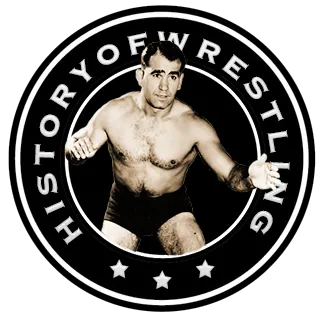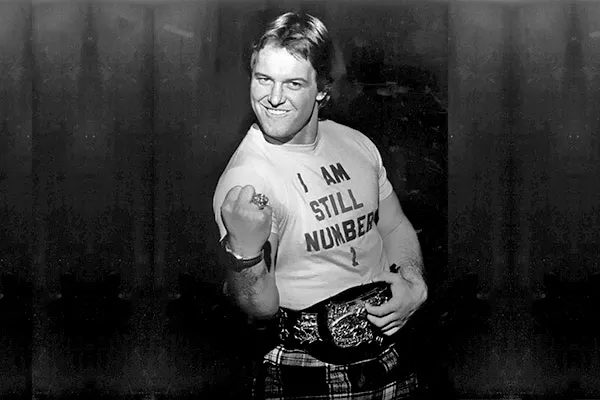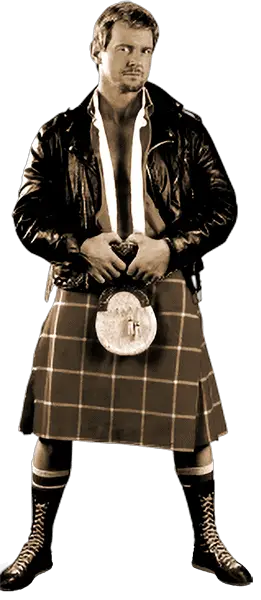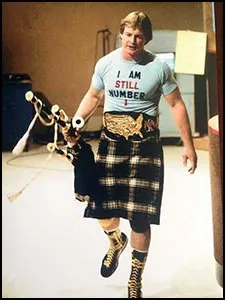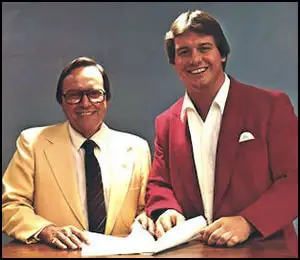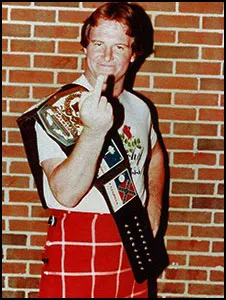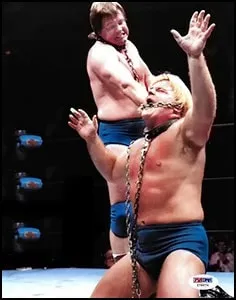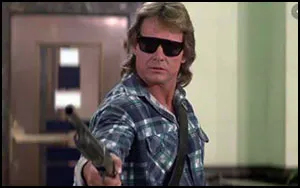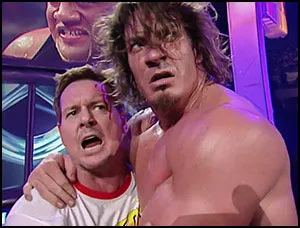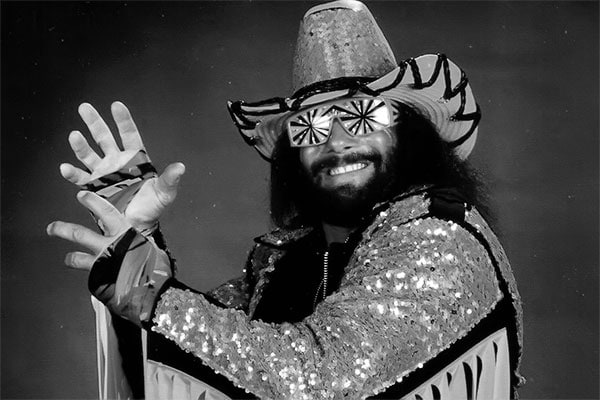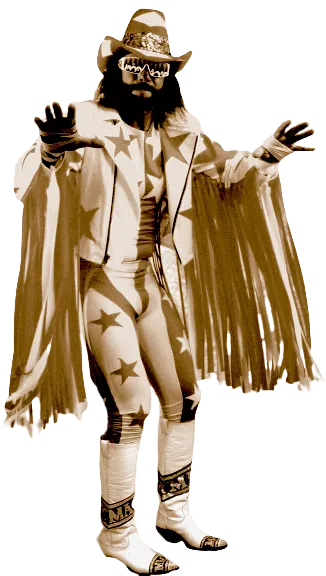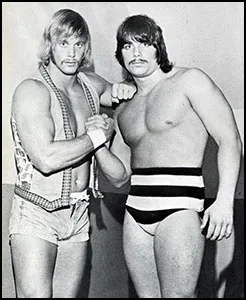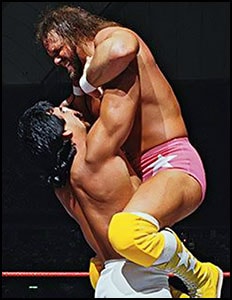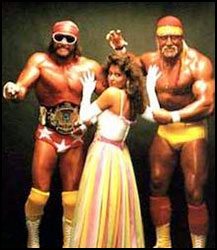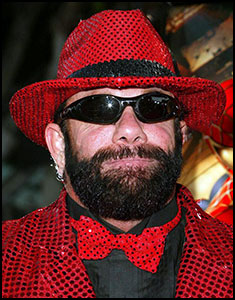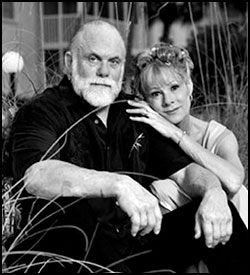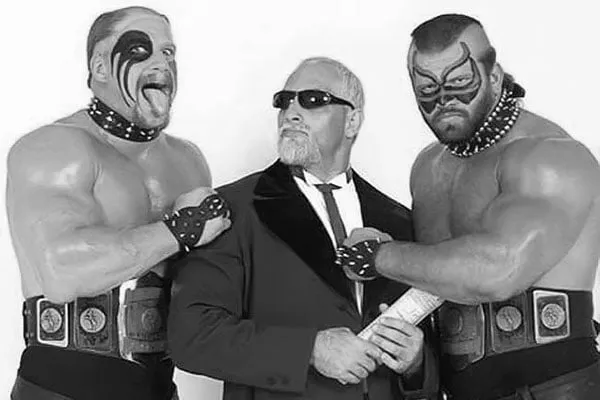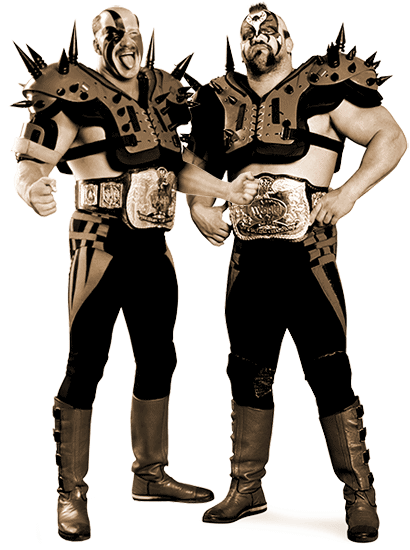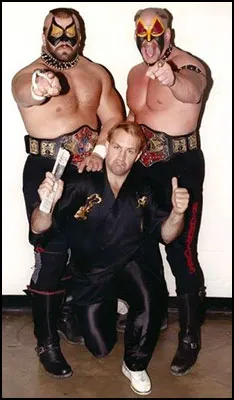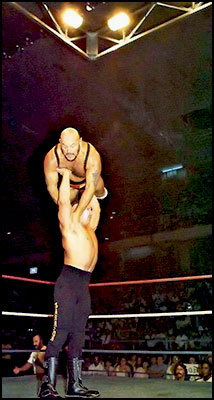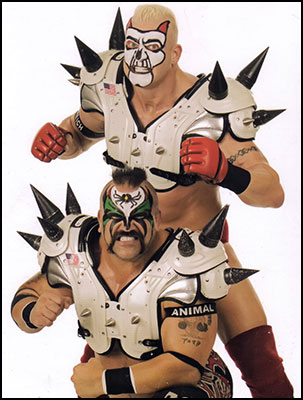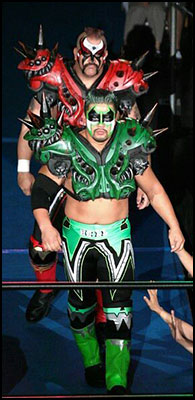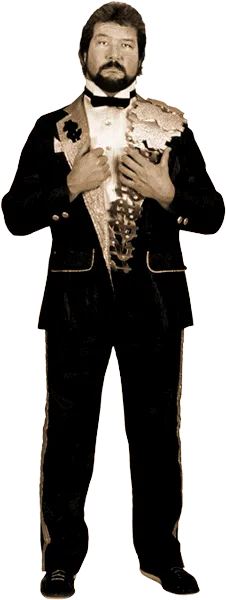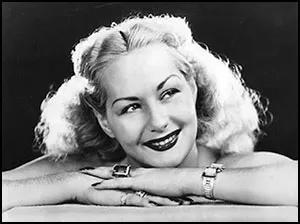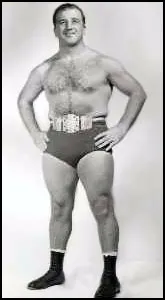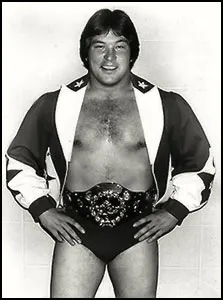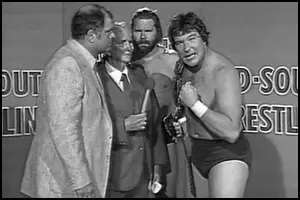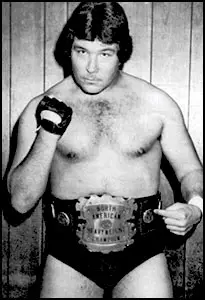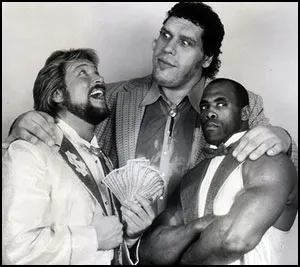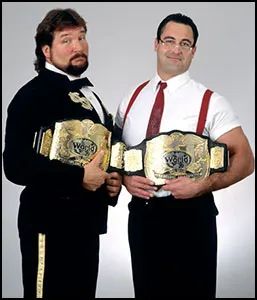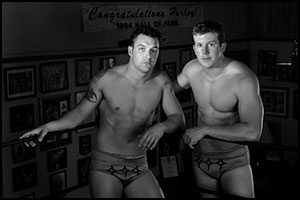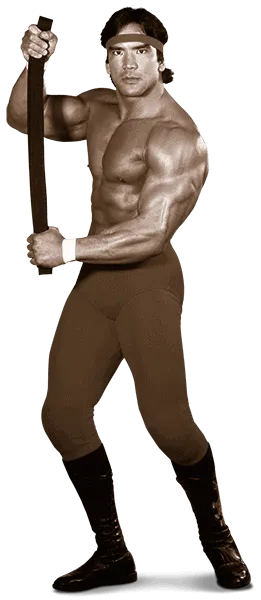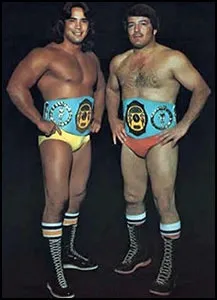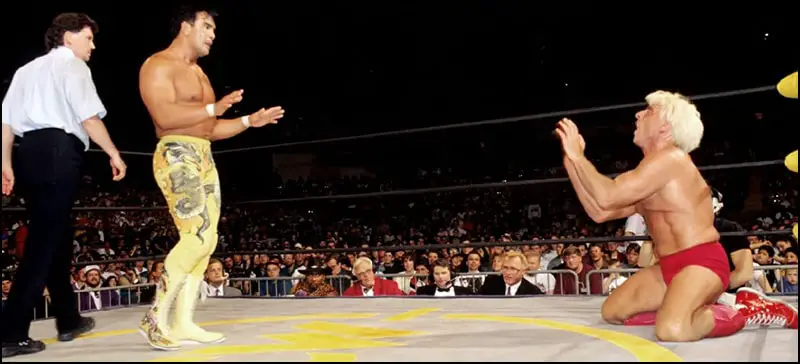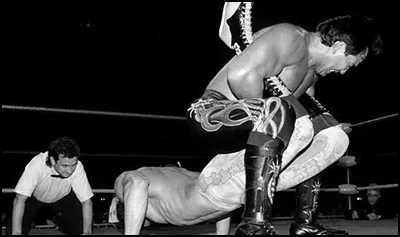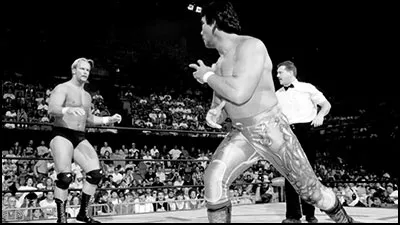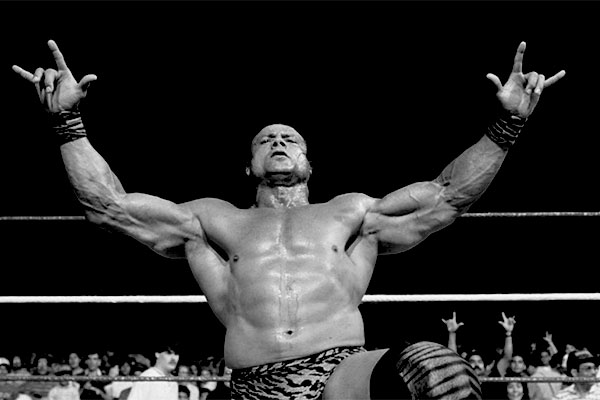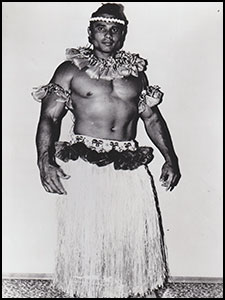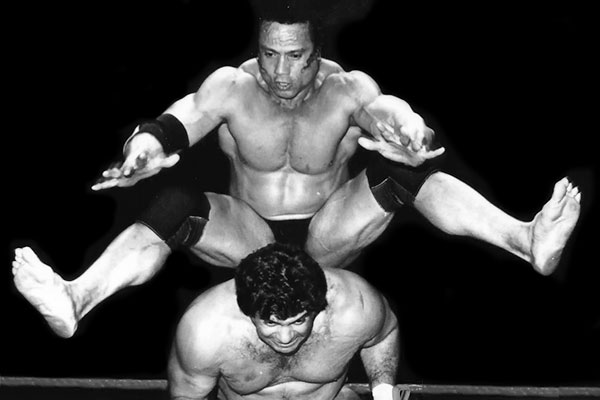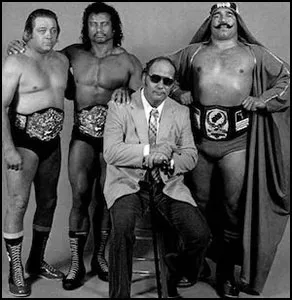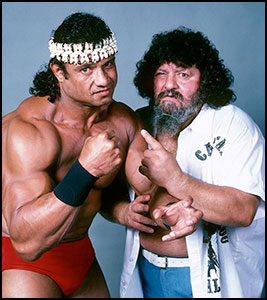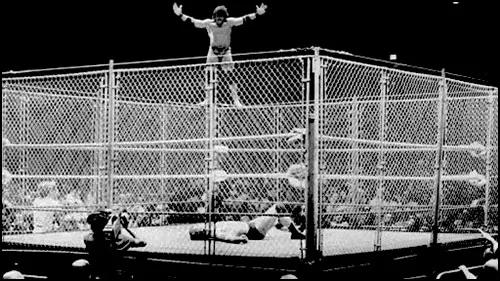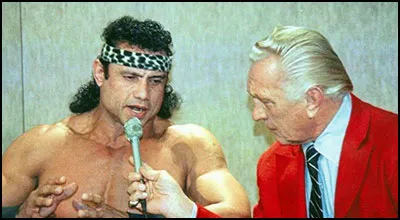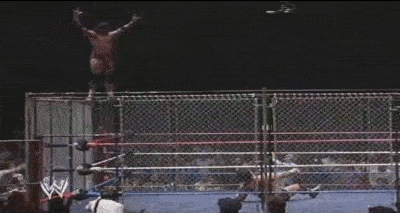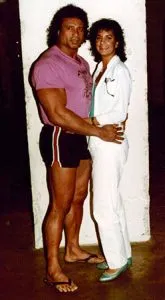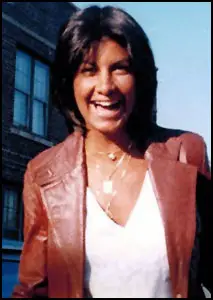ssa
by Stephen Von Slagle
“Just when you think you have all the answers, I change the questions!”
“Rowdy” Roddy Piper has gone down in wrestling history as one of the greatest promo men of all time, with good reason. His superlative interview skills and unique delivery style went virtually unrivaled during his prime and led him to the very top of his profession. During the earlier years of his career, his ability to use the microphone enabled the (relatively) physically unimposing Piper, who was most certainly never at a loss for words, to rise to the top of a business that was populated by heavily muscled juggernauts. Indeed, when he first entered the wrestling business as an undersized teenager, the legendary feuds and iconic moments that awaited him in later years were surely just a dream. However, as he grew both physically and professionally, those dreams turned to reality and “The Rowdy Scotsman” eventually rose to a level of fame and stardom that few in the history of the sport have ever achieved. Whether it be as a territorial performer or on the national stage of the WWF or WCW, Piper was, without question, one of professional wrestling’s most controversial figures, both in and out of the ring. While he could never be regarded as a superior ring technician, his lack of scientific ability was more than compensated for by his unique personality, intensity, and charisma. Later, those same features would help him forge a second career in Hollywood as a leading man in both film and television, where he would go on to pave the way for others wrestlers-turned-actors that followed him, such as Hulk Hogan, Dwayne Johnson, Dave Batista, and John Cena.
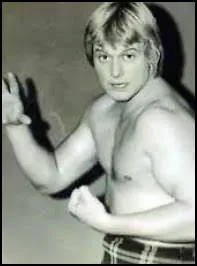 “Rowdy” Roddy Piper was born Roderick George Toombs on April 17, 1954 in Saskatoon, Saskatchewan, Canada. Growing up, he’d had a somewhat troubled youth, to say the least, both at home and at school. Before he’d even reached his freshman year in high school, Toombs had already been expelled and the future superstar was living on his own after leaving home at the tender age of fifteen. He was able to support himself by staying in youth hostels and working odd jobs at various local gyms, where he became proficient at both amateur wrestling and boxing. As a result of spending time at the gym, he was eventually introduced to the world of professional wrestling. He had his first match at the age of just seventeen and, after entering the business full-time in 1973, Piper paid his dues by wrestling at the bottom of the card for smaller territories in Canada as well as Central States, the AWA, and Texas, competing as an enhancement talent. Having gained much in the way of experience, Piper slowly but surely developed as a performer and after several years, his career finally began to take off during the mid-Seventies, first in Los Angeles and then in San Francisco. It was during this time that he developed the persona of a hyperactive kilt-wearing, bagpipe-playing “Scotsman.”
“Rowdy” Roddy Piper was born Roderick George Toombs on April 17, 1954 in Saskatoon, Saskatchewan, Canada. Growing up, he’d had a somewhat troubled youth, to say the least, both at home and at school. Before he’d even reached his freshman year in high school, Toombs had already been expelled and the future superstar was living on his own after leaving home at the tender age of fifteen. He was able to support himself by staying in youth hostels and working odd jobs at various local gyms, where he became proficient at both amateur wrestling and boxing. As a result of spending time at the gym, he was eventually introduced to the world of professional wrestling. He had his first match at the age of just seventeen and, after entering the business full-time in 1973, Piper paid his dues by wrestling at the bottom of the card for smaller territories in Canada as well as Central States, the AWA, and Texas, competing as an enhancement talent. Having gained much in the way of experience, Piper slowly but surely developed as a performer and after several years, his career finally began to take off during the mid-Seventies, first in Los Angeles and then in San Francisco. It was during this time that he developed the persona of a hyperactive kilt-wearing, bagpipe-playing “Scotsman.”
On March 12, 1976, Piper defeated the popular Chavo Guerrero in Los Angeles to become the NWA Americas champion, by far the biggest victory of his career up to that point. Not only did this win over Guerrero put the young rule-breaker on the map as a regional box-office attraction, it also launched a very bitter, emotional feud between Piper and the talented, high-flying young Mexican-American superstar (as well as the rest of the Guerrero family) that would rage for years. As their rivalry continued on and grew in intensity, Piper and Guerrero battled over both pride and the Americas championship, trading the prestigious title back and forth several times between 1976-1979. In terms of the Tag Team division, Piper was equally successful and he won the NWA Americas Tag Team title three times in 1976 (twice with Crusher Verdu and once with The Hangman) and again in 1977 with another young up-and-comer named Keith Franke, who later gained fame as Adrian Adonis.
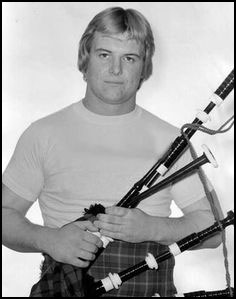 Towards the end of 1977, Piper also began appearing in Roy Shire’s San Francisco-based Big Time Wrestling promotion while still competing in the Los Angeles territory. On June 24, 1978, he defeated area legend “Moondog” Lonnie Mayne for the prestigious United States championship and, just as he had done in L.A., Piper established himself as one of the most controversial heels in Northern California. During his time in the two California promotions, Roddy Piper enjoyed no less than five reigns as the NWA Americas champion, an additional five stints as co-holder of the NWA Americas Tag Team championship, and runs as the U.S. champion and NWA World Light-Heavyweight champion. Ever more impressive was the fact that Piper held each of these titles before he had reached his twenty-fifth birthday.
Towards the end of 1977, Piper also began appearing in Roy Shire’s San Francisco-based Big Time Wrestling promotion while still competing in the Los Angeles territory. On June 24, 1978, he defeated area legend “Moondog” Lonnie Mayne for the prestigious United States championship and, just as he had done in L.A., Piper established himself as one of the most controversial heels in Northern California. During his time in the two California promotions, Roddy Piper enjoyed no less than five reigns as the NWA Americas champion, an additional five stints as co-holder of the NWA Americas Tag Team championship, and runs as the U.S. champion and NWA World Light-Heavyweight champion. Ever more impressive was the fact that Piper held each of these titles before he had reached his twenty-fifth birthday.
Having conquered the state of California, he furthered his base of operations by travelling north to Oregon, where Piper’s winning ways continued. At the same time, behind the scenes, Piper developed a close friendship with Portland promoter Don Owen that he would maintain until Owen’s passing in 2002. The brash young heel captured the NWA Pacific Northwest Heavyweight title by going over the rugged New Zealander Jonathan Boyd on February 17, 1979 and he held the prestigious regional title for four months before dropping the belt to former WWWF champion Stan Stasiak. Later in 1979, Piper, who had maintained his presence in San Francisco, teamed with “Easy” Ed Wiskoski (later known as Col. DeBeers) to win the San Francisco version of the NWA World Tag Team title.
Although he was still largely unknown to fans beyond the West Coast, by the time the Seventies had ended and the Eighties began, Piper’s stock as a money-drawing performer was gaining attention from other promoters throughout the country and it was during this time period that he truly began to emerge as a legitimate wrestling star. No longer a seen as an inexperienced Lightweight who should be relegated to the smaller territories within the NWA, the brash young Piper, whose 6’2″ frame had filled out to 230 lbs., was booked into some of the top regions of the country and he began to make an impact nationally. Shortly after entering the booming Mid Atlantic territory in the Fall of 1980, Piper immediately made his mark by defeating Paul Jones in the finals of a tournament to crown the new Mid Atlantic TV champion. Then, after enjoying two months as the TV champion, Piper gladly vacated this ‘stepping-stone’ title when he shocked the wrestling world by defeating the heavily favored Ric Flair on January 27, 1981 to become the new NWA United States champion. The prestigious U.S. Heavyweight championship was definitely the biggest title win of his career up to that point and his victory over “The Nature Boy” seemed to give Piper instant credibility with fans across the country, serving notice to the public that “Rowdy” Roddy Piper had finally arrived. After holding back the challenge of the former champion Flair in a series of brutal rematches, the young-but-experienced Roddy Piper went on to enjoy a lengthy and successful reign as the United States champion, the #1 wrestler in the territory and top contender for the NWA title, before eventually being toppled by Wahoo McDaniel some eight after months after winning the prized championship.
In the months following his loss to McDaniel, Piper made his debut as a color commentator on the most-watched wrestling program of the day, Georgia Championship Wrestling, which was seen nationwide on Superstation TBS. At the time, Piper was still a relative unknown to the vast majority of wrestling fans when he joined longtime play-by-play man, “The Dean of Wrestling Announcers” Gordon Solie, on the highly-rated Saturday evening program. However, that would soon change. Originally, Piper was very neutral in his commentary, and while he definitely pointed out any rule infractions made by the “good guys,” he also showed no favoritism towards the heels. At the same time, the broadcast team of Solie & Piper truly complimented each other, and their chemistry behind the microphone was evident from the start. Meanwhile, at the same time he was announcing in Georgia, Piper continued competing in the neighboring Mid Atlantic region.
As time passed, though, Piper’s new calm & cool demeanor ever-so-slowly began to give way to the hyperactive, confrontational Piper of old. At first, Piper would slip in an occasional off-the-cuff comment about one of the Georgia fan favorites. But then, over the course of several weeks, his verbal attacks became more frequent and biting. Also, more often than not, the target of his biased commentary was the popular father-son combo of Bob & Brad, The Armstrongs. Originally, Piper seemed to be giving praise to the popular NWA National Tag Team champions, especially the 19-year-old Brad Armstrong. In fact, Piper began going out of his way to point out how Brad was carrying the weight of the team, and that his father’s influence was actually stifling the young star’s potential. Naturally, the elder Armstrong took exception to Piper’s comments, and after weeks of verbal antagonism from Piper, “Bullet” Bob finally snapped. The ensuing Piper vs. Armstrongs feud set the already successful Georgia territory on fire, and “Rowdy” Roddy Piper quickly became the most despised man in the promotion. Conversely, Piper, a wrestler that the Georgia fans truly loved to hate, became the biggest heel in the territory; in addition to his intense rivalry with the Armstrongs, Piper also found himself involved in several bitter feuds against other top Georgia fan favorites, including former NWA champions Tommy “Wildfire” Rich and Dusty Rhodes, as well as the legendary Mr. Wrestling II.
Eventually, Piper left his announcing duties and returned to full-time action. However, after a conflict with booker Ole Anderson led to Piper’s firing from the Georgia promotion, he once again began competing exclusively in the Mid Atlantic territory. In November of 1981, he defeated the ultra-popular Rick Steamboat to win the region’s second most prestigious championship, the Mid Atlantic Heavyweight title, in Greensboro, North Carolina. As always, Piper wasted no time in establishing himself as a controversial and dominant heel champion, and he went on to hold the coveted regional championship for six months before finally being defeated by former NWA World champion Jack Brisco on March 10, 1982. From there, Piper and Brisco engaged in a heated rivalry that lasted for months and resulted in several title changes. Two months after losing his Mid Atlantic championship to Brisco, Piper regained the title on July 7, 1982, seemingly evening the score. Then, just a month later, Brisco got the last laugh when he defeated Piper for the championship in Raleigh, North Carolina. But, a few months following his loss to Brisco, Piper (who had, by this time, once again begun taking bookings in Georgia in addition to his Mid Atlantic schedule) was quickly back in the championship picture and he regained the Mid Atlantic TV title by upending Dick Slater on March 27, 1983 in Asheville, North Carolina, only to lose the belt back to Slater a little over a month later.
However, perhaps more importantly, somewhere along the way, the Mid Atlantic fan’s hated for the hyperactive, scheming and underhanded Piper began to metamorphosis into an unexpected respect and admiration. Indeed, Piper (heretofore the consummate pro wrestling heel) suddenly, surprisingly emerged as one of the babyface-rich Mid Atlantic region’s top fan favorites. That status was also established in Georgia when, during an episode of Georgia Championship Wrestling, Piper rescued his former announcing partner Gordon Solie from an unwarranted attack by Don Muraco. By coming to the aid of the popular (and defenseless) announcer from the bullying Muraco, Piper instantly converted those who had hated him for so long into enthusiastic fans.
With Georgia and Mid Atlantic wrestling fans solidly in his corner, Piper became a two-time United States champion by defeating the talented and dangerous Greg “The Hammer” Valentine in April of 1983, touching off another bitter feud that lasted for months before culminating in one of the most famous pay-off matches in history. With the inaugural Starrcade as the stage, Piper and Valentine pummeled, battered and bloodied each other in a legendary Dog Collar Match that will never be forgotten by those who witnessed it. The impact Piper made while wrestling in the Mid Atlantic and Georgia territories was truly profound, and within three years, he went from being virtually unknown to the vast majority of wrestling fans to establishing himself as one of the elite performers in the business. With his name value at an all-time high, and having honed his considerable mic skills to perfection, it’s no surprise that Piper was contacted by the World Wrestling Federation during the earliest stages of Vince McMahon’s national expansion. Having conquered the two most successful promotions in the entire NWA, Piper, in a life-altering decision, opted to explore the new opportunities that were awaiting him in the WWF.
Upon entering the Federation early in 1984, the talented young veteran (who, by the time he entered the WWF, was only 30 years of age yet had nearly fifteen years of ring experience to his credit) discarded his babyface persona and quickly became the single most hated man in the WWF. Yet, at the same time, he was undoubtedly also one of the most entertaining, and without Piper’s stellar performances as the WWF’s top heel, it’s quite possible that those early years of the WWF and Hulk-a-mania would not have been nearly as successful.
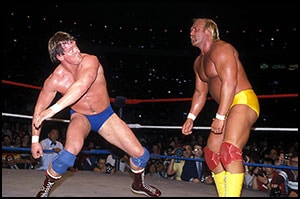 And speaking of The Hulkster, Piper (with his ever-present bodyguard, Bob “Ace” Orton, by his side) was WWF champion Hulk Hogan’s primary challenger for quite some time in the months following Hogan’s WWF title victory over The Iron Sheik. Indeed, the long-running Hogan-Piper feud was one of the most important (and profitable) in World Wrestling Federation history, and it eventually headlined the main-event of the inaugural WrestleMania, which featured Hogan teaming with TV & film star Mr. T to face the duo of Piper & Paul Orndorff. While his cheating methods and choice of opponents definitely enhanced his status as ring villain, it was Piper’s exemplary speaking skills that truly put him over the top as the WWF’s most hated heel. His unique ability to genuinely infuriate the audience was clearly a rare and valuable skill, one that WWF owner Vince McMahon wisely took full advantage of.
And speaking of The Hulkster, Piper (with his ever-present bodyguard, Bob “Ace” Orton, by his side) was WWF champion Hulk Hogan’s primary challenger for quite some time in the months following Hogan’s WWF title victory over The Iron Sheik. Indeed, the long-running Hogan-Piper feud was one of the most important (and profitable) in World Wrestling Federation history, and it eventually headlined the main-event of the inaugural WrestleMania, which featured Hogan teaming with TV & film star Mr. T to face the duo of Piper & Paul Orndorff. While his cheating methods and choice of opponents definitely enhanced his status as ring villain, it was Piper’s exemplary speaking skills that truly put him over the top as the WWF’s most hated heel. His unique ability to genuinely infuriate the audience was clearly a rare and valuable skill, one that WWF owner Vince McMahon wisely took full advantage of.

Piper’s Pit
Soon after his arrival, Piper began hosting a weekly interview segment called “Piper’s Pit” and each week the controversial “Hot Rod” would interview a WWF superstar, most of whom were popular babyfaces. The segments were designed to advance ongoing feuds and, as was often the case, launch new ones. For instance, Piper’s famed wars with Jimmy “Superfly” Snuka, Bruno Sammartino and several others all began as a result of an angle that happened during an episode of “Piper’s Pit.”
The unique idea of having a heel host a talk segment would go on to be a very successful and influential concept, one that, in the following years, spawned many imitations including “The Flower Shop” (Adrian Adonis/WWF), “The Danger Zone” (Paul E. Dangerously/NWA), “The Snake Pit” (Jake Roberts/WWF), “A Flair for the Gold” (Ric Flair/WCW), “The Heart Break Hotel” (Shawn Michaels/WWF) and countless others. However, despite the very entertaining moments created by these “Piper’s Pit” imitators, none of them could duplicate the excitement and controversy that was created by the original…which says more about the host than the idea itself.
Over the course of the next several years, “Rowdy” Roddy continued to entertain his audience while maintaining his status as one of the WWF’s most famous names. As had been the case in the NWA several years earlier, the WWF fans slowly began to respect the crazy, but tough-as-nails Piper. He eventually made the transition from a hated heel to a beloved babyface, a status that he would enjoy for the remainder of his career, which, considering his talent at portraying a heel, is a bit surprising. In 1987, the now incredibly popular Piper made the surprising announcement that he was retiring from wrestling and that his upcoming match with Adrian Adonis at WrestleMania III would, in fact, be his last. While it is natural for wrestling fans to take any type of retirement announcement with a grain of salt, Piper seemingly proved the sceptics wrong by actually disappearing for quite some time after his victory over Adonis. And, as the fans would soon learn, he did so with good reason.
While he is best known for starring in the 1988 classic They Live, Piper actually began his movie career a decade earlier when he landed a minor role in Carl Reiner’s 1978 film The One And Only, which starred Henry Winkler. Capitalizing on the worldwide famed he had gained as one of the WWF’s top names, Piper truly got his foot in the door of the movie industry beginning in 1986 when he landed major roles in Body Slam and Hell Comes to Frogtown, both of which were modest hits. However, Piper truly struck pay-dirt in 1988 when he was hired by veteran director John Carpenter to star in the sci-fi thriller They Live. Grossing $13 million ($28.5 million in 2020 currency) the film was a major success at the box-office and Piper received universally positive reviews for his performance in the film. The success of They Live enabled Piper to continue his ‘retirement’ from wrestling by keeping very busy in Hollywood, both in film and on television. Eventually, though, he did return to professional wrestling during the early-Nineties. Having been a main-event level competitor in the World Wrestling Federation for nearly a decade, Piper finally won his first (and, up to that point, only) WWF title when he captured the Intercontinental championship by defeating The Mountie (Jacques Rougeau) on January 19, 1992 in Albany, New York. However, after waiting all of those years to win a WWF title belt, Piper’s run with the I-C gold would turn out to be relatively short-lived. Following a heated program against The Mountie, Piper dropped the title to a friendly rival, Bret “Hitman” Hart, on March 5, 1992 in Indianapolis’ Hoosier Dome at WrestleMania VIII.
After losing the Intercontinental title, Piper made the transition from wrestler to commentator, a position at which he excelled. Serving as lead announcer Vince McMahon’s color commentator on the WWF’s main syndicated program, WWF Superstars of Wrestling as well as on pay-per-view and, for a time, Monday Night Raw, Piper was able to continue pursuing his goals in Hollywood, while maintaining a high-profile position in the business. This was the case for several years, until the mid-nineties when he was lured back into ring action by the controversial, pseudo-homosexual performer named Goldust. It was against Goldust that Piper engaged in the final feud of his initial run with WWE, which culminated in a wild, no-holds-barred “Hollywood Back Lot Brawl” at WrestleMania XII. Following his entertaining and rather violent program with Goldust, the popular veteran again faded from the wrestling scene and returned to Hollywood. However, as had always been the case with previous Piper retirements, the continued call of the ring was too loud for “The Hot Rod” to ignore. Yet, this time around, the sounds were emanating not from Titan Tower in Stamford, but rather, from Ted Turner’s Atlanta-based WCW.
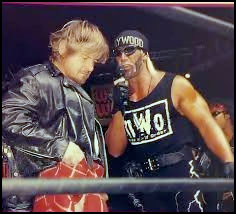 In 1996, Piper made his surprising WCW debut by entering the promotion and immediately renewing his classic feud with Hulk Hogan, who by this time was leading the NWO as “Hollywood” Hogan. While their matches in WCW where generally far less exciting than their wars had been ten years earlier in the WWF, the Hogan-Piper feud garnered several very good buy-rates for WCW pay-per-views, and this second phase of their long-running feud was definitely a financial success, if not an artistic one. During the last few years of the Nineties, whether as a wrestler or as the WCW Commissioner, Piper (along with his longtime friend, “Nature Boy” Ric Flair) remained a major thorn in the side of the New World Order, feuding not only with Hollywood Hogan, but also with NWO co-founders Scott Hall and Kevin Nash, as well as Syxx (X-Pac). Then, on February 8, 1999, nearly twenty years since his last reign as the U.S. Heavyweight champion, Piper defeated Bret “Hitman” Hart to capture the WCW United States title in Buffalo, New York. His run with the belt, however, would turn out to be short-lived when he lost the championship to Scott Hall just two weeks later at SuperBrawl IX in Oakland, California.
In 1996, Piper made his surprising WCW debut by entering the promotion and immediately renewing his classic feud with Hulk Hogan, who by this time was leading the NWO as “Hollywood” Hogan. While their matches in WCW where generally far less exciting than their wars had been ten years earlier in the WWF, the Hogan-Piper feud garnered several very good buy-rates for WCW pay-per-views, and this second phase of their long-running feud was definitely a financial success, if not an artistic one. During the last few years of the Nineties, whether as a wrestler or as the WCW Commissioner, Piper (along with his longtime friend, “Nature Boy” Ric Flair) remained a major thorn in the side of the New World Order, feuding not only with Hollywood Hogan, but also with NWO co-founders Scott Hall and Kevin Nash, as well as Syxx (X-Pac). Then, on February 8, 1999, nearly twenty years since his last reign as the U.S. Heavyweight champion, Piper defeated Bret “Hitman” Hart to capture the WCW United States title in Buffalo, New York. His run with the belt, however, would turn out to be short-lived when he lost the championship to Scott Hall just two weeks later at SuperBrawl IX in Oakland, California.
During the following twelve months, Piper maintained his presence on WCW programming, engaging in upper mid-card programs with Ric Flair, Buff Bagwell, and WCW Creative Director Vince Russo. However, after nearly thirty years in the business, the 46-year-old Piper had accumulated more than his share of injuries, which began to show in his ring work. Conversely, his lucrative deal with WCW placed Piper among the promotion’s top earners at a time when the company’s financial standing was tenuous at best. The decision was made not to renew his contract when it expired and Piper’s six-year run with World Championship Wrestling came to an end in July of 2000. Following his tenure with WCW, he returned home to Portland in order to spend time with his wife and children, as well as to heal his battle-torn body. However, not surprisingly, he did eventually get involved with wrestling again, by promoting independent cards in the Pacific Northwest and serving as the commissioner for the short-lived XWF. Additionally, following his retirement from active competition, Piper continued working in Hollywood as an actor.
Although his in-ring performance was severely hampered by this point, Piper’s name value was as high as ever and an eventual return to the WWF seemed inevitable. On March 30, 2003, “The Rowdy One” made a surprise run-in during the Hulk Hogan vs. Vince McMahon match at WrestleMania XIX in Seattle, Washington, where he attacked Hogan with a steel pipe, re-establishing his heel status. Piper then went on to align himself with Sean O’Haire, serving as the potential-filled O’Haire’s mentor. However, following a controversial, much-publicized interview on HBO’s Real Sports with Bryant Gumbel in June of 2003, during which Piper shed a very negative light on wrestling promoters (Vince McMahon included), the rampant use of drugs in wrestling, and darker side of the business as a whole, he was abruptly released from his WWE contract.
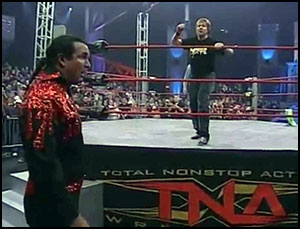 He quickly rebounded, though, and starting in the Fall of 2003, Piper began appearing on TNA Impact Wrestling via taped video segments until he eventually appeared in person, once again as a babyface, on October 8, 2004. Appearing live in the Impact Zone, Piper announced his new segment, which was called, appropriately enough, “In the Pit with Piper.” Over the course of the following three months, the “In the Pit with Piper” segment advanced several storylines for TNA, both on television and pay-per-view. However, his run with the promotion was ultimately fairly short and Piper made his last appearance in TNA at Final Resolution on January 16, 2005, when he refereed a match between Jeff Hardy vs. Scott Hall.
He quickly rebounded, though, and starting in the Fall of 2003, Piper began appearing on TNA Impact Wrestling via taped video segments until he eventually appeared in person, once again as a babyface, on October 8, 2004. Appearing live in the Impact Zone, Piper announced his new segment, which was called, appropriately enough, “In the Pit with Piper.” Over the course of the following three months, the “In the Pit with Piper” segment advanced several storylines for TNA, both on television and pay-per-view. However, his run with the promotion was ultimately fairly short and Piper made his last appearance in TNA at Final Resolution on January 16, 2005, when he refereed a match between Jeff Hardy vs. Scott Hall.
Then, in 2007, Piper, still an iconic name but no longer an in-ring competitor, returned to WWE and began making sporadic guest appearances on Monday Night Raw and Smackdown. After re-establishing himself as a WWE personality, Piper was involved (along with Jimmy Snuka and Ricky Steamboat) in a WrestleMania match involving the pre-Randy Orton “legend killer,” Chris Jericho. Following his WrestleMania XXV appearance, the “Hot Rod” continued to be a WWE personality, including his induction of Wendy Richter into the WWE Hall of Fame on March 27, 2010 and an angle with Zack Ryder at WrestleMania XXVII on April 3, 2011. Piper’s final WWE match came on June 13, 2011, nearly forty years after his pro wrestling debut, when he defeated The Miz. Although he was no longer a full-time performer, he remained a part of the WWE Universe, with the last of his sporadic appearance on RAW taking place on December 22, 2014, followed by his final WWE appearance ever at WrestleMania XXXI on March 29, 2015, where Piper, along with several other WWE superstars, took part in a post-match locker room celebration after Daniel Bryan came out on top of a seven-way-showdown for the Intercontinental Championship.
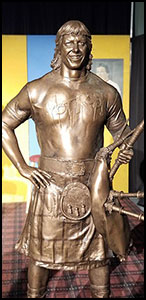 “Rowdy” Roddy Piper is a member of the Wrestling Observer Newsletter Hall of Fame (1996), the WWE Hall of Fame (2005), the Professional Wrestling Hall of Fame and Museum (2007), the George Tragos/Lou Thesz Professional Wrestling Hall of Fame (2008), and he posthumously received the PWI Stanley Weston Award in 2015.
“Rowdy” Roddy Piper is a member of the Wrestling Observer Newsletter Hall of Fame (1996), the WWE Hall of Fame (2005), the Professional Wrestling Hall of Fame and Museum (2007), the George Tragos/Lou Thesz Professional Wrestling Hall of Fame (2008), and he posthumously received the PWI Stanley Weston Award in 2015.
On July 31, 2015, just three months after his final wrestling appearance, Roderick “Roddy Piper” Toombs died in his sleep, a victim of cardiopulmonary arrest. He was 61 years old.
by Mark Long
He was an icon of the 1980s and 1990s, with a trademark phrase and an oversized personality. But he was plagued by his demons, jealousy and paranoia, and lived in the shadows of some of the greatest professional wrestlers in the history of the business. But Randy Savage was special, a phenom among a locker room of talent, destined to be an enigma in life and beloved in death.
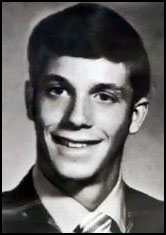 Randy Savage was born Randy Mario Poffo in Columbus, Ohio on November 15, 1952. He was the eldest son of Judy Poffo and her husband, wrestler Angelo Poffo. Judy and Angelo met as students at DePaul University and when a fastball to the head derailed his dreams of a career in baseball, he became a well-known professional wrestler in the 1950s and 1960s, winning the NWA United States Heavyweight Championship (Chicago version) from Wilbur Snyder in 1958. He was also famous for being featured in Ripley’s Believe It or Not! for executing 6,033 sit-ups in 4 hours, 10 minutes. When Randy was two years old, his brother Lanny was born and he would also become a professional wrestler. As the family of a wrestling star, the Poffos moved around a lot, and Randy lived in Zanesville, Ohio, Downers Grove, Illinois, Staten Island, New York and eventually Lexington, Kentucky. In high school Randy excelled at sports, lettering in baseball, football and basketball and was a National Honor Society member. He turned down a scholarship offer from Arizona State University and entered the Major League Baseball draft. Dejected after going undrafted he attended Southern Illinois University–Carbondale, from which he graduated in 1971.
Randy Savage was born Randy Mario Poffo in Columbus, Ohio on November 15, 1952. He was the eldest son of Judy Poffo and her husband, wrestler Angelo Poffo. Judy and Angelo met as students at DePaul University and when a fastball to the head derailed his dreams of a career in baseball, he became a well-known professional wrestler in the 1950s and 1960s, winning the NWA United States Heavyweight Championship (Chicago version) from Wilbur Snyder in 1958. He was also famous for being featured in Ripley’s Believe It or Not! for executing 6,033 sit-ups in 4 hours, 10 minutes. When Randy was two years old, his brother Lanny was born and he would also become a professional wrestler. As the family of a wrestling star, the Poffos moved around a lot, and Randy lived in Zanesville, Ohio, Downers Grove, Illinois, Staten Island, New York and eventually Lexington, Kentucky. In high school Randy excelled at sports, lettering in baseball, football and basketball and was a National Honor Society member. He turned down a scholarship offer from Arizona State University and entered the Major League Baseball draft. Dejected after going undrafted he attended Southern Illinois University–Carbondale, from which he graduated in 1971.
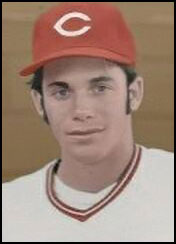 After finishing college, Randy decided to pursue a career in baseball, having been drafted out of high school by the St. Louis Cardinals. He had been a two-time All-State catcher at Downers Grove North High School in Illinois, and joined the Sarasota Cardinals of the Gulf Coast League where he hit .286 in his first year in rookie ball. The next year was even better as he was named to the GCL All-Star team as a hard hitting outfielder and in 1973 he hit .344 in 25 games as a designated hitter for the Sarasota Red Birds. The next year, however, he was promoted to Class-A ball with Orangeburg of the Western Carolinas League, and his batting average plummeted to a weak .250. In 1974 he moved to Tampa Bay, Florida to play for the Cincinnati Reds affiliate in the Florida State league and his numbers skewed downwards again, batting .232, with nine home runs and 66 RBIs. After being released by the Reds, he was invited to try out for the Chicago White Sox Class-A affiliate. Because of a shoulder injury, he began throwing left-handed and moved to first base, but again, failed to gain a spot. He finished his minor league career with 289 games in four minor league seasons, with a .254 batting average, 16 home runs and 129 RBIs.
After finishing college, Randy decided to pursue a career in baseball, having been drafted out of high school by the St. Louis Cardinals. He had been a two-time All-State catcher at Downers Grove North High School in Illinois, and joined the Sarasota Cardinals of the Gulf Coast League where he hit .286 in his first year in rookie ball. The next year was even better as he was named to the GCL All-Star team as a hard hitting outfielder and in 1973 he hit .344 in 25 games as a designated hitter for the Sarasota Red Birds. The next year, however, he was promoted to Class-A ball with Orangeburg of the Western Carolinas League, and his batting average plummeted to a weak .250. In 1974 he moved to Tampa Bay, Florida to play for the Cincinnati Reds affiliate in the Florida State league and his numbers skewed downwards again, batting .232, with nine home runs and 66 RBIs. After being released by the Reds, he was invited to try out for the Chicago White Sox Class-A affiliate. Because of a shoulder injury, he began throwing left-handed and moved to first base, but again, failed to gain a spot. He finished his minor league career with 289 games in four minor league seasons, with a .254 batting average, 16 home runs and 129 RBIs.
An excellent athlete born into a wrestling family, Randy may have had other options, but he had a family legacy to fall back on. So in 1973, while still playing baseball, he began working with his father and brother, wrestling across the midwest and south. He began wrestling under a mask as “the Spider” (perhaps to hide his identity as a Poffo). At some point while wrestling in Georgia Championship Wrestling, booker Ole Anderson convinced home drop Poffo from his wrestling name and to change it to Savage, saying that Poffo was too tame of a name for someone who wrestled like a savage. At some point, Angelo became dissatisfied with the push that his sons were receiving and decided to establish his own promotion, International Championship Wrestling (ICW). Because his promotion competed in the mid-western states against promotions that were sanctioned for those territories, ICW was considered an outlaw promotion, finding itself at odds with major promotions in the region. The Poffos were tough, however, and would not be intimidated, operating for six years with Randy and Lanny as the featured talent. Also featured on the ICW weekly television show was interviewer Liz Hulette, who would later gain fame as Savage’s wife and manager Miss Elizabeth. The promotion had engaged in a bitter feud against Continental Wrestling Association which was owned by Jerry Jarrett and Jerry Lawler and when television ratings and attendance at house shows dwindled significantly, ICW shuttered its doors, selling its assets to CWA. Because of the feud between the promotions, Randy and Lanny were natural heels when they began working for Jarrett and Lawler. Randy teamed with Lanny in battles against the Rock ‘n Roll Express to much acclaim and Savage had periods of matches against Lawler fighting for the AWA Southern Heavyweight championship. The feud ended on June 7, 1985 when Lawler beat him in a “Loser Leaves Town” match in Memphis, Tennessee. Throughout his run in CWA, Randy showed his versatility, switching back and forth from the role of a babyface to a heel and back again, and he gained notoriety as a potential megastar in the business.
 Savage brought a unique persona to the ring. John Pantozzi’s description of him was that “in appearance, he lassoed a rainbow and wore it for all to see.” Everything about him was over the top, from his colorful monogrammed capes, fringed wrestling tights, oversized sunglasses to his raspy-voice and measured speaking style. Whereas latter day wrestling fans would seek to hijack wrestlers’ promos with chants of “what,” Savage was impossible not to pay attention to, in part because he legitimately looked like he might come unglued and attack an audience member. His overprotectiveness of Elizabeth played into many of his storylines, and while many argued that it was over exaggerated, just as many felt that he had an irrationality about their relationship that was overbearing and even dangerous. All of these wrapped together along with his fast-paced aggressive wrestling style made him one of the top prospects in the business.
Savage brought a unique persona to the ring. John Pantozzi’s description of him was that “in appearance, he lassoed a rainbow and wore it for all to see.” Everything about him was over the top, from his colorful monogrammed capes, fringed wrestling tights, oversized sunglasses to his raspy-voice and measured speaking style. Whereas latter day wrestling fans would seek to hijack wrestlers’ promos with chants of “what,” Savage was impossible not to pay attention to, in part because he legitimately looked like he might come unglued and attack an audience member. His overprotectiveness of Elizabeth played into many of his storylines, and while many argued that it was over exaggerated, just as many felt that he had an irrationality about their relationship that was overbearing and even dangerous. All of these wrapped together along with his fast-paced aggressive wrestling style made him one of the top prospects in the business.
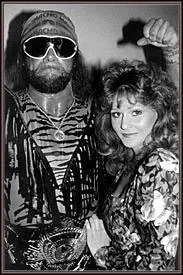 It did not take long for him to gain that status as the World Wrestling Federation came calling. Savage was featured in promotional segments as the top free agent in all of wrestling and was coming to the promotion. An angle was set up where all of the top managers in the WWF were vying to represent him, but instead he announced, with great fanfare, that his new manager would be the lovely Miss Elizabeth. This introduced the demure and delicate Elizabeth as a contrast to the volatile, paranoid Savage. His WWF pay-per-view debut saw him fight his way through a 16-man battle royal before losing as the last participant to the Junkyard Dog. He then began a feud with Tito Santana over the Intercontinental Title (IC) belt which he eventually won on February 24, 1986 in the Boston Gardens arena. The Intercontinental title was usually a stepping stone towards a challenge for the WWF Heavyweight belt and he matched up with the WWF champion Hulk Hogan in a series of matches. Savage beat Hogan on several of these occasions via count out, but because the belt could not change hands because of a count out, he walked away empty-handed. What he walked into, however, was a dream feud against veteran wrestler George “the Animal” Steele. Steele had long been an animalistic heel, but in the feud he had fallen in love with Elizabeth and often interceded when she was being manhandled by Savage. This saw them matchup for the IC title at Wrestlemania II in a cage match in Nassau Veterans Memorial Coliseum in Uniondale, New York. Although Steele was able to kick out of Savage’s patented elbow drop, Randy gained a roll-up pinfall by using both of his feet on the ropes for extra leverage.
It did not take long for him to gain that status as the World Wrestling Federation came calling. Savage was featured in promotional segments as the top free agent in all of wrestling and was coming to the promotion. An angle was set up where all of the top managers in the WWF were vying to represent him, but instead he announced, with great fanfare, that his new manager would be the lovely Miss Elizabeth. This introduced the demure and delicate Elizabeth as a contrast to the volatile, paranoid Savage. His WWF pay-per-view debut saw him fight his way through a 16-man battle royal before losing as the last participant to the Junkyard Dog. He then began a feud with Tito Santana over the Intercontinental Title (IC) belt which he eventually won on February 24, 1986 in the Boston Gardens arena. The Intercontinental title was usually a stepping stone towards a challenge for the WWF Heavyweight belt and he matched up with the WWF champion Hulk Hogan in a series of matches. Savage beat Hogan on several of these occasions via count out, but because the belt could not change hands because of a count out, he walked away empty-handed. What he walked into, however, was a dream feud against veteran wrestler George “the Animal” Steele. Steele had long been an animalistic heel, but in the feud he had fallen in love with Elizabeth and often interceded when she was being manhandled by Savage. This saw them matchup for the IC title at Wrestlemania II in a cage match in Nassau Veterans Memorial Coliseum in Uniondale, New York. Although Steele was able to kick out of Savage’s patented elbow drop, Randy gained a roll-up pinfall by using both of his feet on the ropes for extra leverage.
 Randy continued competing against Steele but then transitioned towards a new feud against Ricky “the Dragon” Steamboat. The two rivals were superior athletes and their bouts often contrasted with many of the plodding matches that were common in the WWF. The feud was built up magnificently as Savage attacked Steamboat who was greeting fans on the November 22, 1986 episode of WWF Superstars of Wrestling. Savage draped Steamboat neck across the barricade and leaped off of the turnbuckle and delivered a double- axe-handle to the back of his neck, pulverizing his throat. He then rolled Ricky into the ring, grabbed the bell from ringside and jumped off of the turnbuckle, and slammed it into Steamboat’s throat. Steamboat shuddered in agony, unable to breathe. This storyline was stretched out for months as cameras watched the Dragon trying to rehabilitate. Finally, the two were to meet at Wrestlemania III in a match that would be heralded as the greatest ever presented by the WWF.
Randy continued competing against Steele but then transitioned towards a new feud against Ricky “the Dragon” Steamboat. The two rivals were superior athletes and their bouts often contrasted with many of the plodding matches that were common in the WWF. The feud was built up magnificently as Savage attacked Steamboat who was greeting fans on the November 22, 1986 episode of WWF Superstars of Wrestling. Savage draped Steamboat neck across the barricade and leaped off of the turnbuckle and delivered a double- axe-handle to the back of his neck, pulverizing his throat. He then rolled Ricky into the ring, grabbed the bell from ringside and jumped off of the turnbuckle, and slammed it into Steamboat’s throat. Steamboat shuddered in agony, unable to breathe. This storyline was stretched out for months as cameras watched the Dragon trying to rehabilitate. Finally, the two were to meet at Wrestlemania III in a match that would be heralded as the greatest ever presented by the WWF.
While most matches in wrestling are called in the ring and done on the fly, Savage was notorious for his insistence in laying a match out in the locker room. Announcer Gene Okerlund would recall that “Savage was obsessed with things being absolutely perfect and tight in his matches.” Lanny would blame it on Savage having OCD, but explained that Randy was a perfectionist. “You heard the expression sports entertainment? Well, Randy believed in both. He believed in entertainment — that would be the robe, the gimmick, the interview, the ring color and pizzazz. But he also believed in sports and had a chip on his shoulder to prove that he was the greatest athlete who ever lived.” Thus, he wanted the match to be the best one on the Wrestlemania card.
Behind the scenes, Savage and Steamboat laid out the intricate plans for the match and the three months spent with vignettes demonstrating the severity of Steamboat’s injuries had the fans in a frenzy on the day of their match. Dave Hebner was the referee and as both wrestlers were driven through the Pontiac Silverdome, the crowd roared with excitement. Once in the ring, Steamboat immediately sought revenge, choking Savage with a Hangman maneuver. The match went back and forth with 22 near falls. The crowd was electric when Savage sent Steamboat to the ground in the middle of the ring after Hebner took a bump and was disoriented. Savage grabbed the ring bell and climbed onto the turnbuckle, ready to repeat his previous attack to the Dragon’s throat, but was stopped by Steele, who pitched Savage off of the turnbuckle, onto the mat. With his back injured, Savage scooped up Steamboat for a bodyslam, but Rick turned it into a roll-up and secured a pinfall. The crown went crazy as Hebner presented Steamboat the belt and Ricky and Steele left the ring to applause. Savage was left in the ring with an anguished Elizabeth by his side, defeated, humbled… and knowing he had just had the best match of his career. The Wrestlemania match stole the show and many, if not most, fans consider it the greatest WWF match in history. It was named 1987’s Match of the Year by both the Wrestling Observer Newsletter and Pro Wrestling Illustrated, but as Lanny later explained, for Savage it became a match he could never top, a fact that would haunt him in years to come.
Despite being a hated villain, Savage’s brilliance in the ring, as well as his energetic promos, had fans lining up to see him and as his popularity began to grow, he found more people cheering him than booing him. After winning the King of the Ring on September 4, 1987 at the Providence Civic Center in Providence, Rhode Island, Savage eased up in his overbearing treatment of Elizabeth and hostility towards the fans, and he found himself headed for a shot to reclaim the IC belt, now held by the Honkytonk Man. During their match on the October 3, 1987 episode of Saturday Night’s Main Event, the match was interrupted by the Hart Foundation, with Honkytonk subsequently smashing a guitar over Savage’s head. Elizabeth ran to get help and returned with Hulk Hogan in tow. Hogan stormed the ring and the heels began beating him down before he fought them off with the help of a revived Savage and after the two backed into one another and faced off with clenched fists, Savage extended his hand and the Mega Powers were formed.
Savage and Honkytonk engaged in numerous battles over the next several months, both in one-on-one action and in group tag team action. Savage was pursuing Honkytonk’s Intercontinental belt, wanting to use it as a stepping stone towards the WWF championship. Behind the scenes, however, Honkytonk refused to drop the belt to Savage, arguing that he was too successful at the time to lose his momentum and that Savage didn’t need the belt to be considered a legit challenger for the WWF World title. As a result, their feud ended with a series of blow-off matches between Savage and Honkytonk team in cage matches. For Savage, the failure to capture the IC strap was just a blip on the screen as he had bigger things ahead of him.
On February 5, 1988, the WWF broadcast “The Main Event” from the Market Square Arena in Indianapolis, Indiana. During the broadcast, champion Hulk Hogan faced Andre the Giant in a rematch of their historic battle at Wrestlemania III. In this match, Andre defeated Hogan, when referee Dave Hebner’s twin brother Earl (who was working on behalf of Ted Dibiase) worked the match ostensibly as Dave. When Andre covered Hogan late in the match, Earl delivered a three count pinfall to Andre, despite Hogan’s shoulders clearly being up at the one-count. While Hogan protested, Andre held the belt high, then immediately presented it to Dibiase, thus selling the title to the Million Dollar Man. Minutes later, as Hogan scrambled at Andre and Dibiase, fans in the arena roared as Dave Hebner ran from the back and climbed into the ring to confront his brother Earl. Hogan spotted the two and grabbed them trying to figure what was going on. As the two brothers argued, Earl knocked Dave to the ground and then kicked him. Hogan then picked Earl up and threw him over the ropes and out of the ring, where he was caught by Andre. 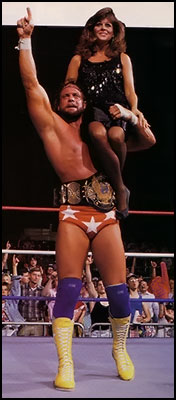 As a result of this, while Andre was recognized as the victor in the match and new champion, his selling the belt to Dibiase was improper as the title could only change hands via a pinfall or submission, and the title was therefore vacated. As a result, a 14 man tournament was slated for Wrestlemania IV to determine the new WWF World Heavyweight champion.
As a result of this, while Andre was recognized as the victor in the match and new champion, his selling the belt to Dibiase was improper as the title could only change hands via a pinfall or submission, and the title was therefore vacated. As a result, a 14 man tournament was slated for Wrestlemania IV to determine the new WWF World Heavyweight champion.
The Macho Man was considered a favorite in the tournament and he defeated “The Natural” Butch Reed, Greg “The Hammer” Valentine and the One Man Gang to reach the finals, where he would face “The Million Dollar Man,” Ted Dibiase. Hogan, who was disqualified along with Andre in their match, sat down at ringside in order to prevent any interference. In the finals of the tournament. Randy pinned Dibiase to capture the World title, after Hogan had hit Dibiase with a chair. Savage, Hogan and Miss Elizabeth celebrated the victory in the ring and the Mega Powers were united once again.
For the next 371 days, Randy Savage defended his world title against formidable foes such as One Man Gang, the Big Boss Man and André the Giant. But he was even more popular when he teamed up with Hogan as the Mega Powers and faced the Mega Bucks (Andre and Dibiase) and then against the Twin Towers (The Big Boss Man and Akeem the Dream), with the Mega Powers winning matches at the first Summer Slam event and at the 1988 Survivors Series.
In addition to being a team in the ring, Savage and Hogan developed a friendship outside of the ring as well, with Elizabeth becoming a very close confidant of Hogan’s wife Linda. Good times, however, would not last forever. After Hogan took on Elizabeth as his manager as well, he accidentally eliminated Savage from a Royal Rumble match on January 15, 1989 and the two began to fight in the ring before Elizabeth separated them. Five weeks later, in a match against the Twin Towers during the Main Event II, Elizabeth was injured. When Hogan carried her to the back, Savage flipped out and abandoned Hogan in the ring, with Randy accusing Hogan of trying to steal Elizabeth from him. On April 2, 1989, the stage was set for Savage to defend his title against Hogan at Wrestlemania V. Despite being hospitalized with an elbow infection, Savage showed up for the match and battled the Hulk for 17 minutes before being pinned.
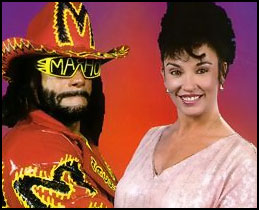 Now without the championship belt, Savage was also without Miss Elizabeth, as she stayed in Hogan’s corner as his manager, so Randy replaced her with Sensational Sherri Martel. He and Hogan continued to face one another for the next few months, often with Hogan teaming with Brutus Beefcake against Randy and Tiny “Zeus” Lister. After winning the 1989 King of the Ring tournament by pinning Jim Duggan, Randy proclaimed himself the “Macho King.” During his coronation as the King, he was awarded a scepter by Ted Dibiase and was accompanied by his brother Lanny, now performing in the WWF as “The Genius.” As The King, he faced Hulk Hogan once again for the WWF World Heavyweight championship but lost on a pinfall when guest referee, boxing champion Buster Douglas counted to three despite Savage’s shoulder being up at the count of two.
Now without the championship belt, Savage was also without Miss Elizabeth, as she stayed in Hogan’s corner as his manager, so Randy replaced her with Sensational Sherri Martel. He and Hogan continued to face one another for the next few months, often with Hogan teaming with Brutus Beefcake against Randy and Tiny “Zeus” Lister. After winning the 1989 King of the Ring tournament by pinning Jim Duggan, Randy proclaimed himself the “Macho King.” During his coronation as the King, he was awarded a scepter by Ted Dibiase and was accompanied by his brother Lanny, now performing in the WWF as “The Genius.” As The King, he faced Hulk Hogan once again for the WWF World Heavyweight championship but lost on a pinfall when guest referee, boxing champion Buster Douglas counted to three despite Savage’s shoulder being up at the count of two.
The Macho Man then engaged in matches over the next year with Dusty Rhodes and the Ultimate Warrior. At Wrestlemania VII, Savage faced the Warrior in a retirement match. After hitting Savage with several shoulder blocks, The Warrior stood on the Macho Man and was awarded the pinfall. An enraged Sherri attacked the Macho Man for losing the match but was chased off by Elizabeth who was in the crowd watching. The couple reunited on screen, turning Randy back into a crowd favorite. Despite the retirement stipulation, Savage finished out a few more matches, the last being on April 1, 1991 in Kobe, Japan where he was defeated by Genichiro Tenryu.
Although retired, Savage continued working for the WWF, this time in the capacity as a color-commentator on the television broadcasts. At the same time, the WWF continued to focus on the relationship with Elizabeth, with Randy proposing to her and a marriage ceremony being held at SummerSlam 1991 in a segment that was dubbed the “the Match Made in Heaven.” Later, at their televised wedding reception, Elizabeth opened a present which contained a live snake, courtesy of Jake “the Snake” Roberts. Savage begged the WWF for reinstatement as a wrestler, but was turned down by WWF President Jack Tunney. 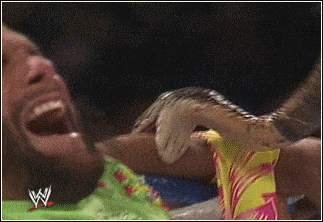 Later, on the October 21, 1991 broadcast of WWF Superstars of Wrestling, Roberts stood in the ring and insulted the Macho Man who was working ringside at the commentary table. He goaded Savage into the ring and then attacked him, leaving him tied in the ring ropes. Jake then pulled a live King Cobra snake out of a bag and caused it to legitimately bite Randy on the arm for more than 30 seconds (while the snake had been devenomized, Roberts struggled to get it to release Savage from its fangs). “That’s a really funny story because the snake was supposed to be devenomized, and when (it) bit me, it wouldn’t let go,” Savage recalled in an interview with the IGN website. “About five days later I had a fever and went to the hospital with a 104-degree fever. It’s unbelievable to walk into the hospital and tell the doctor I had a snake bite. Finally the fever went down, they gave me antibiotics, and luckily the snake was devenomized, but twelve days later the snake died. He was devenomized but maybe I wasn’t. [laughs] Jake told me: “’You killed my snake dude.’” After this incident the Macho Man was successful in getting reinstated and faced Roberts in a series of matches all the way through February of 1992.
Later, on the October 21, 1991 broadcast of WWF Superstars of Wrestling, Roberts stood in the ring and insulted the Macho Man who was working ringside at the commentary table. He goaded Savage into the ring and then attacked him, leaving him tied in the ring ropes. Jake then pulled a live King Cobra snake out of a bag and caused it to legitimately bite Randy on the arm for more than 30 seconds (while the snake had been devenomized, Roberts struggled to get it to release Savage from its fangs). “That’s a really funny story because the snake was supposed to be devenomized, and when (it) bit me, it wouldn’t let go,” Savage recalled in an interview with the IGN website. “About five days later I had a fever and went to the hospital with a 104-degree fever. It’s unbelievable to walk into the hospital and tell the doctor I had a snake bite. Finally the fever went down, they gave me antibiotics, and luckily the snake was devenomized, but twelve days later the snake died. He was devenomized but maybe I wasn’t. [laughs] Jake told me: “’You killed my snake dude.’” After this incident the Macho Man was successful in getting reinstated and faced Roberts in a series of matches all the way through February of 1992.
 Randy next set his sights on WWF champion Ric Flair. Flair had shown a series of vignettes in which he stated that he had been in an intimate relationship with Elizabeth, corroborated by a series of photographs of the couple smiling by the poolside. The photos were later shown to have been doctored, as WWF Magazine showed the original photos of Elizabeth and Savage compared to the photos presented by Flair, with him substituted in Savage’s place.
Randy next set his sights on WWF champion Ric Flair. Flair had shown a series of vignettes in which he stated that he had been in an intimate relationship with Elizabeth, corroborated by a series of photographs of the couple smiling by the poolside. The photos were later shown to have been doctored, as WWF Magazine showed the original photos of Elizabeth and Savage compared to the photos presented by Flair, with him substituted in Savage’s place.
The two wrestlers feuded during this time, ostensibly over Elizabeth’s honor and Savage took the belt from Flair at Wrestlemania VIII in Indianapolis, Indiana on April 5, 1992. While a return to the championship should have been a tremendous moment for Savage and Elizabeth, things were dramatically different behind the scenes, as the marriage between Randy and Elizabeth was coming to an end, all while it was played out to be blissfully solid on tv. Randy was known backstage to be almost psychotically jealous and protective of Elizabeth, ordering other wrestlers to stay away from her and reportedly once locking her in a backstage room to prevent any wrestlers from talking to her. The couple divorced on September 18, 1992 with Elizabeth’s final WWF appearance being at the UK Rampage show on April 19, 1992. Savage even got into it with Hulk Hogan years earlier when Hogan lifted Elizabeth into the ring and Savage accused him of “copping a feel.” After the divorce (which was announced in WWF Magazine) Savage apparently held Hogan and his wife responsible for much of the discord between Elizabeth and him and held a grudge against Hogan that lasted for years.
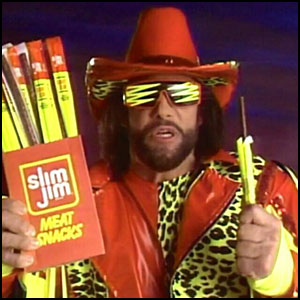 Savage’s popularity had gained him mainstream recognition and in 1993 he was hired as a spokesman for the Slim Jim beef jerky product. His catch phrase for his commercials for the product was “Need a little excitement? Snap into a Slim Jim!” He would continue hawking Slim Jim’s until 2000.
Savage’s popularity had gained him mainstream recognition and in 1993 he was hired as a spokesman for the Slim Jim beef jerky product. His catch phrase for his commercials for the product was “Need a little excitement? Snap into a Slim Jim!” He would continue hawking Slim Jim’s until 2000.
Over the next few months, the Macho Man defended his World title belt against the Ultimate Warrior before losing it back to Flair in September, in part due to interference from Razor Ramon. For the next two years, Savage engaged in singles and tag matches against the top names in the promotion. He also served as a color commentator on the newly launched Monday Night Raw television show and on PPVs. He performed in these roles until his contract with WWF expired in November of 1994.
Although Vince McMahon decided that Randy Savage’s time as an in-ring competitor had come to an end, Savage himself felt that he still had much to accomplish as a wrestler. As 1994 came to a close, so, too, did Savage’s career in the World Wrestling Federation. The Macho Man then made his debut in World Championship Wrestling on the December 3, 1994, edition of WCW Saturday Night, alluding to his past with Hulk Hogan and ambiguously hinting that the feud might be rekindled now that they were in the same promotion again. However, the opposite turned out to be the case and at Starrcade ’94, Savage came to Hogan’s aid when the Hulkster was being beaten down by Kevin Sullivan’s Faces of Fear.
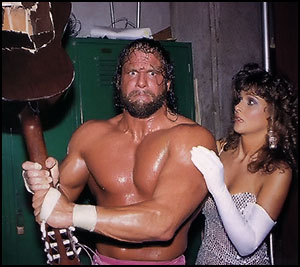 Once his position as a babyface had been established in WCW, Savage entered into his first major feud, competing against former WWF rival “Nature Boy” Ric Flair. The Savage-Flair series headlined WCW’s television and pay-per-view events for several months during 1995, delivering exciting angles and quality matches at the top of the card while Hogan was away from the spotlight, filming one of his various acting projects. On November 26, 1995, Randy Savage won his first WCW World Heavyweight title at the inaugural World War 3 pay-per-view when he outlasted 60 other competitors to become champion. The victory, however, was short-lived, as just one month later, he lost the championship to Ric Flair at Starrcade ’95. Yet, Savage would rebound and he soon regained the World title from “The Nature Boy” on the January 22, 1996, edition of Monday Nitro. As his ongoing program with Flair (which would eventually involve Savage’s ex-wife Elizabeth as well as his father, Angelo Poffo) continued to play out on WCW programming, Randy Savage would again drop the title to Flair, this time during a steel cage showdown on February 11, 1996 at SuperBrawl VI in St. Petersburg, Florida.
Once his position as a babyface had been established in WCW, Savage entered into his first major feud, competing against former WWF rival “Nature Boy” Ric Flair. The Savage-Flair series headlined WCW’s television and pay-per-view events for several months during 1995, delivering exciting angles and quality matches at the top of the card while Hogan was away from the spotlight, filming one of his various acting projects. On November 26, 1995, Randy Savage won his first WCW World Heavyweight title at the inaugural World War 3 pay-per-view when he outlasted 60 other competitors to become champion. The victory, however, was short-lived, as just one month later, he lost the championship to Ric Flair at Starrcade ’95. Yet, Savage would rebound and he soon regained the World title from “The Nature Boy” on the January 22, 1996, edition of Monday Nitro. As his ongoing program with Flair (which would eventually involve Savage’s ex-wife Elizabeth as well as his father, Angelo Poffo) continued to play out on WCW programming, Randy Savage would again drop the title to Flair, this time during a steel cage showdown on February 11, 1996 at SuperBrawl VI in St. Petersburg, Florida.
The lengthy series between the two superstars would continue on through to the summer of 1996, at which time Savage, as well as WCW itself, became caught up in the revolutionary storyline of the emerging New World Order. Indeed, Savage was a major player within the match that actually launched the NWO when he teamed with Sting to face Scott Hall & Kevin Nash, The Outsiders, in the main-event of Bash at the Beach ’96. Following Hulk Hogan’s unexpected heel-turn, Randy Savage was one of the main defenders of WCW and he stood with Sting, Lex Luger, D.D.P. and others to fend off the onslaught of the villainous invading faction. However, despite his high standing in the company, when he could not come to terms on a new contract with the promotion, Savage briefly disappeared from WCW programming until making a surprise return in January of 1997.
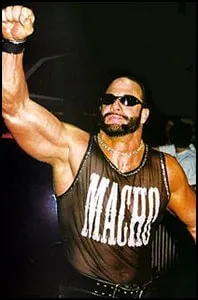 When he returned to action, he complained that he was being blackballed by the promotion. He sought out the company of Sting who was engaged in a one-man war against the NWO and the two appeared at WCW shows watching from the shadows. WCW President Eric Bischoff (who was also a member of the NWO) told Savage that he was unwelcome in WCW and would only be allowed back in the promotion if it was as a member of the NWO. At the SuperBrawl VII pay-per-view on February 23, 1997 from the Cow Palace in San Francisco, California, Savage did just that, abandoning Sting. He reunited with Miss Elizabeth, who was now a member of the NWO and the two began feuding with Diamond Dallas Page and his wife Kimberly for the next eight months. He next feuded with Lex Luger, but his eyes were set on his former compatriot Sting, who was now in possession of the WCW title belt. He got his shot at the champion at Spring Stampede 1988 and despite interference from Hulk Hogan and tearing an ACL during the match, Randy defeated Sting via pinfall in just over ten minutes. He was aided by Kevin Nash during the match as well as the next night on Monday Nitro. This caused a fissure in the NWO and Savage, Nash and others split off to form NWO Wolfpac, abandoning Hogan and his followers. Savage then proceeded to feud with Bret Hart and Roddy Piper, but midway through the year, he disappeared from television to go and have surgery on his knee.
When he returned to action, he complained that he was being blackballed by the promotion. He sought out the company of Sting who was engaged in a one-man war against the NWO and the two appeared at WCW shows watching from the shadows. WCW President Eric Bischoff (who was also a member of the NWO) told Savage that he was unwelcome in WCW and would only be allowed back in the promotion if it was as a member of the NWO. At the SuperBrawl VII pay-per-view on February 23, 1997 from the Cow Palace in San Francisco, California, Savage did just that, abandoning Sting. He reunited with Miss Elizabeth, who was now a member of the NWO and the two began feuding with Diamond Dallas Page and his wife Kimberly for the next eight months. He next feuded with Lex Luger, but his eyes were set on his former compatriot Sting, who was now in possession of the WCW title belt. He got his shot at the champion at Spring Stampede 1988 and despite interference from Hulk Hogan and tearing an ACL during the match, Randy defeated Sting via pinfall in just over ten minutes. He was aided by Kevin Nash during the match as well as the next night on Monday Nitro. This caused a fissure in the NWO and Savage, Nash and others split off to form NWO Wolfpac, abandoning Hogan and his followers. Savage then proceeded to feud with Bret Hart and Roddy Piper, but midway through the year, he disappeared from television to go and have surgery on his knee.
 When he returned in April 1999, he was a whole new man. He sported earrings, a ponytail and a new girlfriend, Gorgeous George (Stephanie Bellars) who served as his valet. They were soon joined by Madusa Micelli and Miss Madness (who later wrestled as Molly Holly) and pursued the WCW World Heavyweight title again. In a convoluted and nonsensical tag match between Kevin Nash and Sting against Randy and Sid Vicious, Savage through a stipulation won his fourth WCW championship. He lost the belt the next night on Monday Nitro to Hogan and went on to feud with professional basketball star Dennis Rodman, culminating in a victory at Road Wild 1999 in Sturgis, South Dakota. His star in WCW began fading and he made his last appearance for the promotion on the May 3, 2000, episode of Thunder. After several years of hiatus, he returned to wrestling, beginning a feud with Jeff Jarrett in the Total Nonstop Action promotion in November 2004, but left just a month later after a disagreement over a proposed finish at a pay-per-view.
When he returned in April 1999, he was a whole new man. He sported earrings, a ponytail and a new girlfriend, Gorgeous George (Stephanie Bellars) who served as his valet. They were soon joined by Madusa Micelli and Miss Madness (who later wrestled as Molly Holly) and pursued the WCW World Heavyweight title again. In a convoluted and nonsensical tag match between Kevin Nash and Sting against Randy and Sid Vicious, Savage through a stipulation won his fourth WCW championship. He lost the belt the next night on Monday Nitro to Hogan and went on to feud with professional basketball star Dennis Rodman, culminating in a victory at Road Wild 1999 in Sturgis, South Dakota. His star in WCW began fading and he made his last appearance for the promotion on the May 3, 2000, episode of Thunder. After several years of hiatus, he returned to wrestling, beginning a feud with Jeff Jarrett in the Total Nonstop Action promotion in November 2004, but left just a month later after a disagreement over a proposed finish at a pay-per-view.
By the end of his career, Savage had not blown through his money like so many wrestlers of his era. He was extremely frugal (a trait he picked up from his father, staying in cheap hotels and eating sandwiches while other superstars of his caliber stayed in five star hotels and ran up $1,000 room service tabs). This allowed him to pursue several avenues in the entertainment industry. He had appeared on an episode of the Baywatch television show in 1996 and episodes of Mad About You and Walker, Texas Ranger in 1999. His real interest was in movies and he debuted in the 2000 release of the wrestling movie Ready to Rumble. His biggest role was in the 2002 blockbuster film Spider-Man in which he portrayed wrestler Buzzsaw McGraw. He also lent his memorable voice to several cartoon television shows and films including King of the Hill, Space Ghost: Coast to Coast and Disney’s The Bolt. He released a rap CD entitled Be A Man in 2003 and appeared in various wrestling video games over the years.
Years into retirement, Savage settled into marriage with Barbara Lynn Payne, whom he called his soulmate, in 2010. He had mellowed considerably and was described as having attained a level of peace that contrasted greatly with his persona as a wrestler as well as his behaviour behind the scenes. The couple moved to Florida and were driving together on May 20, 2011 when Randy suffered a heart attack and crashed into a tree and died. His autopsy showed that he had an enlarged heart and advanced coronary artery disease. His death struck the wrestling industry like a thunderbolt. After he was cremated, his ashes were placed under a favorite tree on his property in Largo, Florida.
Tributes poured in after his death and the WWE released a DVD documentary, Macho Man: The Randy Savage Story, in November 2014. Many fans and fellow wrestlers had complained for years that Randy had not been inducted into the WWE Hall of Fame during his lifetime, so the WWE announced on January 12, 2015 that Savage would headline that year’s Hall of Fame class. He was represented by his brother Lanny and was inducted by Hulk Hogan. He was inducted into the Downers Grove High School Hall of Fame (1994), the Wrestling Observer Newsletter Hall of Fame (1996), the Professional Wrestling Hall of Fame (2009), and the Ilio DiPaolo Legends of the Aud Hall of Fame (2016).
 Randy Savage was a unique and electrifying personality, in all aspects of the game. While he was overshadowed by the outsized personalities of Hulk Hogan and Andre the Giant, he has held up over the years in the high regard in which he is viewed. After referencing legends such as Ric Flair, Lou Thesz, Buddy Rogers and Gorgeous George, Jon Robinson of IGN said “But for my money, for my ticket to that one dream match, when you factor in personality, crowd heat, drawing power, and of course, wrestling ability, from the top rope to the mat, ‘The Macho Man’ Randy Savage is right there with any of those names previously mentioned.”
Randy Savage was a unique and electrifying personality, in all aspects of the game. While he was overshadowed by the outsized personalities of Hulk Hogan and Andre the Giant, he has held up over the years in the high regard in which he is viewed. After referencing legends such as Ric Flair, Lou Thesz, Buddy Rogers and Gorgeous George, Jon Robinson of IGN said “But for my money, for my ticket to that one dream match, when you factor in personality, crowd heat, drawing power, and of course, wrestling ability, from the top rope to the mat, ‘The Macho Man’ Randy Savage is right there with any of those names previously mentioned.”
Sources:
Chicago Tribune – Macho Man’s road to WWE Hall of Fame went through Downers Grove
John Pantozzi – “Macho Man” Randy Savage
IGN Website – Randy Savage Interview
by Stephen Von Slagle
While there have been countless great tag teams during the long history of professional wrestling, duos that enjoyed immense popularity and box-office success, very few rose past their singles counterparts to reach the elite level of genuine main event status. Indeed, the list is quite short. During the 1950s, the incredibly popular tandem of Antonino Rocca & Miguel Perez certainly achieved headliner status, as did Dr. Jerry Graham & Eddie Graham, the infamous Golden Grahams. Later, teams like The Fabulous Freebirds, The Rock n’ Roll Express and The Fabulous Ones each attained a level of exceptional stardom that enabled them to headline regional cards, at least for a time. However, as successful as those great tag teams may have been, none can legitimately compare to the international ticket-selling ability of the Legion of Doom, Hawk & Animal, The Road Warriors. After first bursting onto the wrestling scene early in 1983 via TBS’s World Championship Wrestling, the two gargantuan, massively muscled brawlers, clad in black ring wear, leather motorcycle gear and sporting crew cuts were, visually, quite unique, especially when compared to their contemporaries. But, when Hawk & Animal began wearing war-paint makeup not long after their debut, the infamous Road Warrior look was truly complete. Their trendsetting style and appearance would go on to influence a generation of pro wrestlers and produce numerous imitators over the years, including teams such as Demolition, The Powers of Pain, The Bladerunners and The Ascension. But, as talented and impressive as many of the Road Warrior clones may have been, none came close to having the worldwide impact as did the originals. Not since Andre the Giant had wrestlers appeared as impervious to pain or as unshakable and unbeatable as Hawk & Animal, whose legendary entrance theme, Iron Man by Black Sabbath, became synonymous with their team. As a result, the ever-growing aura of the mighty Road Warriors truly preceded the mammoth duo and, relatively speaking, they became one of the industry’s top attractions virtually overnight.
 The story of The Road Warriors begins not on a post-apocalyptic battlefield or the unforgiving streets of their adopted hometown of Chicago, but, rather, in St. Paul, Minnesota. Having received their initial training at Eddie Sharkey’s camp, Mike “Hawk” Hegstrand and Joe “Animal” Laurinaitis were working as bouncers at a rough Minneapolis bar when they met Ole Anderson, booker for TBS’s World Championship Wrestling. Anderson immediately saw potential in the two hulking bruisers and brought them into his territory. Laurinaitis had a short stint in G.C.W.’s singles ranks wrestling as The Road Warrior before being joined by Hegstrand and forming the team that would soon take the wrestling world by storm.
The story of The Road Warriors begins not on a post-apocalyptic battlefield or the unforgiving streets of their adopted hometown of Chicago, but, rather, in St. Paul, Minnesota. Having received their initial training at Eddie Sharkey’s camp, Mike “Hawk” Hegstrand and Joe “Animal” Laurinaitis were working as bouncers at a rough Minneapolis bar when they met Ole Anderson, booker for TBS’s World Championship Wrestling. Anderson immediately saw potential in the two hulking bruisers and brought them into his territory. Laurinaitis had a short stint in G.C.W.’s singles ranks wrestling as The Road Warrior before being joined by Hegstrand and forming the team that would soon take the wrestling world by storm.
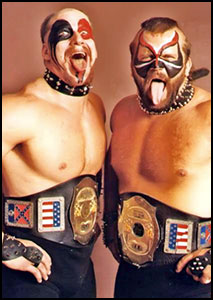 Success came quickly for the technically limited young brawlers, neither of whom had even a year’s worth of experience before being paired together. Indeed, when The Road Warriors made their first appearance in Georgia on June 11, 1983, they did so as champions, wearing the NWA National Tag Team belts after “winning” a fictitious tournament for the vacant championship. While the massive push they received from Georgia Championship Wrestling may have been a bit of a gamble considering their inexperience, it was a calculated risk that certainly paid off. Although they were completely unknown by fans of the time, they were presented in a manner that enabled them to become major attractions immediately. Upon the recommendation of G.C.W. minority owner Bill Watts, Hawk & Animal soon added war paint to their gimmick, an inspired idea that would become synonymous with their imposing look.
Success came quickly for the technically limited young brawlers, neither of whom had even a year’s worth of experience before being paired together. Indeed, when The Road Warriors made their first appearance in Georgia on June 11, 1983, they did so as champions, wearing the NWA National Tag Team belts after “winning” a fictitious tournament for the vacant championship. While the massive push they received from Georgia Championship Wrestling may have been a bit of a gamble considering their inexperience, it was a calculated risk that certainly paid off. Although they were completely unknown by fans of the time, they were presented in a manner that enabled them to become major attractions immediately. Upon the recommendation of G.C.W. minority owner Bill Watts, Hawk & Animal soon added war paint to their gimmick, an inspired idea that would become synonymous with their imposing look.
 While their incredible physiques, unique appearance and fresh, new gimmick were all unquestionably big elements of the Road Warrior’s initial success, another equally important factor was their leader, former wrestler-turned-manager, “Precious” Paul Ellering. Prior to the Road Warriors exploding onto national television via TBS, Ellering (who, like the men he would go on to manage, sported an impressive physique during the prime of his in-ring career) had been a rising star in the AWA and various territories throughout the NWA until injury forced the premature end of his budding wrestling career. As the manager of Hawk and Animal (as well as the masked Spoiler, Jake “The Snake” Roberts and King Kong Bundy) Ellering, the scheming, Wall Street Journal-wielding Legion of Doom mastermind was a unique managerial figure and a key player in several of the Georgia territory’s most successful and entertaining storylines during this time period.
While their incredible physiques, unique appearance and fresh, new gimmick were all unquestionably big elements of the Road Warrior’s initial success, another equally important factor was their leader, former wrestler-turned-manager, “Precious” Paul Ellering. Prior to the Road Warriors exploding onto national television via TBS, Ellering (who, like the men he would go on to manage, sported an impressive physique during the prime of his in-ring career) had been a rising star in the AWA and various territories throughout the NWA until injury forced the premature end of his budding wrestling career. As the manager of Hawk and Animal (as well as the masked Spoiler, Jake “The Snake” Roberts and King Kong Bundy) Ellering, the scheming, Wall Street Journal-wielding Legion of Doom mastermind was a unique managerial figure and a key player in several of the Georgia territory’s most successful and entertaining storylines during this time period.
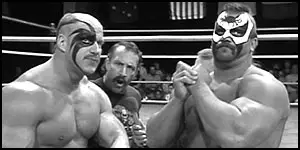 Another aspect of the success of the trio known as the Legion of Doom that became evident early on was their interview ability, which was exceptional. Individually, each performer was able to deliver a better-than-average promo (a primary component in the success of any pro wrestler) and, collectively, the ferocious yet intelligent and, at times, maniacally humorous musclemen always left their viewing public entertained, if not a bit frightened.
Another aspect of the success of the trio known as the Legion of Doom that became evident early on was their interview ability, which was exceptional. Individually, each performer was able to deliver a better-than-average promo (a primary component in the success of any pro wrestler) and, collectively, the ferocious yet intelligent and, at times, maniacally humorous musclemen always left their viewing public entertained, if not a bit frightened.
Following their stay in Georgia, the Warriors traveled to the site of the childhood wrestling memories, Verne Gagne’s American Wrestling Association. As had been the case in Georgia, the L.O.D. made their AWA debut as villainous (but respected) heels and then, eventually, transformed into incredibly popular babyface bulldozers, a formula that proved to be quite successful. Following their win over reigning AWA World Tag Team titleholders The Crusher & Baron Von Raschke in August of 1984, the Road Warriors went on the rule the AWA tag division for more than one year as champions. During their reign as AWA World Tag Team titleholders, The Road Warriors represented their promotion in several AWA-NWA crossover ‘dream matches’ against NWA World Tag Team champions Ivan & Nikita Koloff, matches which helped draw some very large crowds for promoters Verne Gagne and Jim Crockett.
Eventually, the mighty Road Warriors were defeated for their AWA championship by the unlikely duo of “Gorgeous” Jimmy Garvin & “Mr. Electricity” Steve Regal. Garvin and Regal’s win, however, was not without controversy and it was clear to all who witnessed the match that the L.O.D. had been robbed of their World championship. Following the loss of the AWA title, Ellering and his men traveled to Jim Crockett’s NWA promotion, which, by the time the Warriors arrived in 1986, was the home of some of the best tag teams in wrestling history, all of whom were in the prime of their careers. Crockett’s NWA showcased the likes of Jim Cornette and his highly talented Midnight Express, as well as the young and exciting Rock n’ Roll Express. Meanwhile, the powerful Soviet triad of former WWWF champion Ivan Koloff, his nephew “The Russian Nightmare” Nikita Koloff and U.S.-born ‘turncoat’ Krusher Kruschev were a devastating NWA force as well. Of course, the precision and power of Arn Anderson & Tully Blanchard — The Horsemen — certainly cannot be forgotten. In fact, the over-abundance of talent in the NWA’s Tag Team division almost seemed to work against the L.O.D., though not in the way one might first think.
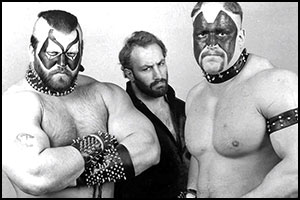 The aura of power and invincibility of The Road Warriors did not wane in light of the NWA’s deeper talent base; in fact, it grew. With so many deserving, quality opponents to put the Warriors up against, NWA matchmakers were able to keep the team that virtually no one could defeat out of the NWA World Tag Team championship picture (at least in terms of them winning the titles) for more than two years. Granted, the Legion of Doom held the on-again-off-again NWA World Six Man Tag team championship for nearly twenty months between 1986-88, however, the Six Man title was (rightfully) viewed by fans as being several notches below the World Tag Team championship in terms of prestige. Still, by having the Warriors battle, say, the Horsemen in a non-title grudge match while The Midnight Express challenged The Rock n’ Roll Express (or vice versa, as the case may have been) for the Tag Team championship, fans were treated to an even better night of action with more meaningful, high-quality matches.
The aura of power and invincibility of The Road Warriors did not wane in light of the NWA’s deeper talent base; in fact, it grew. With so many deserving, quality opponents to put the Warriors up against, NWA matchmakers were able to keep the team that virtually no one could defeat out of the NWA World Tag Team championship picture (at least in terms of them winning the titles) for more than two years. Granted, the Legion of Doom held the on-again-off-again NWA World Six Man Tag team championship for nearly twenty months between 1986-88, however, the Six Man title was (rightfully) viewed by fans as being several notches below the World Tag Team championship in terms of prestige. Still, by having the Warriors battle, say, the Horsemen in a non-title grudge match while The Midnight Express challenged The Rock n’ Roll Express (or vice versa, as the case may have been) for the Tag Team championship, fans were treated to an even better night of action with more meaningful, high-quality matches.
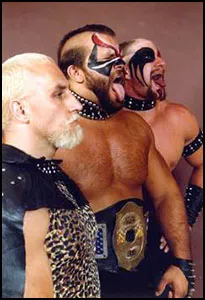 Meanwhile, overseas in Japan, the Warriors wore New Japan Pro Wrestling’s highly respected NWA International Tag Team championship from March of 1987 through June of 1988. As the International Tag Team champions, Hawk & Animal, despite the differences in American and Japanese work styles, dominated the talented, deep Japanese tag ranks as overwhelmingly as they had in their homeland. As top attractions for both Antonio Inoki’s New Japan Pro Wrestling and Shohei “Giant” Baba’s All Japan Pro Wrestling, Hawk & Animal were clearly among the elite U.S. competitors to regularly tour Japan and the Road Warriors quickly gained legendary status in the Land of the Rising Sun.
Meanwhile, overseas in Japan, the Warriors wore New Japan Pro Wrestling’s highly respected NWA International Tag Team championship from March of 1987 through June of 1988. As the International Tag Team champions, Hawk & Animal, despite the differences in American and Japanese work styles, dominated the talented, deep Japanese tag ranks as overwhelmingly as they had in their homeland. As top attractions for both Antonio Inoki’s New Japan Pro Wrestling and Shohei “Giant” Baba’s All Japan Pro Wrestling, Hawk & Animal were clearly among the elite U.S. competitors to regularly tour Japan and the Road Warriors quickly gained legendary status in the Land of the Rising Sun.
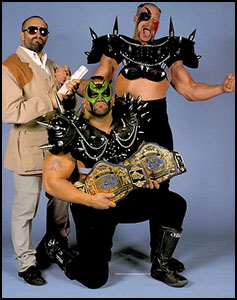 Eventually, back home in the States, the Road Warriors did get their previously elusive NWA World Tag Team championship victory when, following a dramatic and unexpected heel turn, they defeated The Midnight Express on October 29, 1988. Yet, despite a vicious, bloody attack on Dusty Rhodes and a feud with the popular Midnight Express (who were, for the first time, being portrayed as babyfaces) the NWA’s fans just could not embrace the concept of booing the Road Warriors. So, they didn’t. Not surprisingly, it wasn’t long before the L.O.D. was back to facing a new collection of talented NWA heel teams such as the Samoan Swat Team (Fatu & Sumu), Doom (Ron Simmons & Butch Reed) and The Skyskrapers (Sid Vicious & Dan Spivey). However, Animal & Hawk’s run as the NWA World Tag Team champions ended just six months after it began, in the same city where they originally won the belts; New Orleans, Louisiana. On April 2, 1989, The Road Warriors were defeated by The Varsity Club (Kevin Sullivan and Mike Rotundo) for the their belts, which ended their sole reign as NWA World Tag team champions. Later, the Warriors engaged in a memorable feud with manager Paul Jones’ equally strong duo of The Warlord & The Barbarian, the very L.O.D.-ish team known as the Powers of Pain.
Eventually, back home in the States, the Road Warriors did get their previously elusive NWA World Tag Team championship victory when, following a dramatic and unexpected heel turn, they defeated The Midnight Express on October 29, 1988. Yet, despite a vicious, bloody attack on Dusty Rhodes and a feud with the popular Midnight Express (who were, for the first time, being portrayed as babyfaces) the NWA’s fans just could not embrace the concept of booing the Road Warriors. So, they didn’t. Not surprisingly, it wasn’t long before the L.O.D. was back to facing a new collection of talented NWA heel teams such as the Samoan Swat Team (Fatu & Sumu), Doom (Ron Simmons & Butch Reed) and The Skyskrapers (Sid Vicious & Dan Spivey). However, Animal & Hawk’s run as the NWA World Tag Team champions ended just six months after it began, in the same city where they originally won the belts; New Orleans, Louisiana. On April 2, 1989, The Road Warriors were defeated by The Varsity Club (Kevin Sullivan and Mike Rotundo) for the their belts, which ended their sole reign as NWA World Tag team champions. Later, the Warriors engaged in a memorable feud with manager Paul Jones’ equally strong duo of The Warlord & The Barbarian, the very L.O.D.-ish team known as the Powers of Pain.
Following their nearly five-year-long tenure in the NWA, and after remaining one of the few NWA attractions that had not been lured to the WWF, The Road Warriors (minus Paul Ellering and now known exclusively as The Legion of Doom) finally entered the World Wrestling Federation in 1990. Upon their arrival, the L.O.D. quickly settled into major feuds with the two most notable Road Warrior-inspired teams of the era; first, their former NWA rivals The Powers of Pain and, later, Demolition. Hawk & Animal also had an exciting and memorable series with The Hart Foundation. Then, on August 26, 1991, the Legion of Doom made wrestling history by defeating the Nasty Boys and capturing the WWF Tag Team title, thus becoming the only team to have won versions of the World Tag Team championship in each of North America’s “Big Three” promotions; the AWA, NWA and WWF
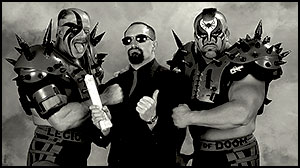 Several months into their WWF tenure, the Legion of Doom was reunited with their longtime manager when Paul Ellering was brought into the promotion. After holding the WWF Tag Team championship for nearly six months, the L.O.D. finally lost the title to Money, Inc. (Ted Dibiase & Mike Rotunda) and February 7, 1992. Meanwhile, behind the scenes, Hegstrand’s ongoing personal issues began developing a rift in his relationship with Laurinaitis and the previously inseparable partners officially split following their appearance at Summerslam 1992 in London.
Several months into their WWF tenure, the Legion of Doom was reunited with their longtime manager when Paul Ellering was brought into the promotion. After holding the WWF Tag Team championship for nearly six months, the L.O.D. finally lost the title to Money, Inc. (Ted Dibiase & Mike Rotunda) and February 7, 1992. Meanwhile, behind the scenes, Hegstrand’s ongoing personal issues began developing a rift in his relationship with Laurinaitis and the previously inseparable partners officially split following their appearance at Summerslam 1992 in London.
After the legendary team parted ways, Hawk returned to Japan and also competed in Europe, where he won the Catch Wrestling Association World Heavyweight title on December 19, 1992. Meanwhile, back in the WWF, Animal formed a short-lived team with Crush (Brian Adams) that was relatively successful, although the “new” L.O.D. never came close to reaching the level of the original team. Within months of Hawk quitting the WWF, Animal left the promotion as well, taking several years off from the sport to rehabilitate a severely injured back.
With Animal out of the picture, Hawk continued focusing on his singles career, with a great deal of success. Eventually, though, he formed a new Road Warrior-inspired team called The Hell Raisers with “The Power Warrior” Kensuke Sasake. The duo (clad in L.O.D.-style war paint and ring attire) was an extremely popular team for New Japan Pro Wrestling. The Hell Raisers wore the prestigious I.W.G.P. World Tag Team title twice; their first reign began on December 14, 1992, and lasted through August 5, 1993, while their second run with the IWGP tag straps began on January 4, 1994, and ended on November 24, 1994. While working for NJPW, Hawk also began wrestling occasionally for WCW as a singles competitor, feuding primarily with WCW International Champion “Ravishing” Rick Rude. Following his stint in WCW, Hawk appeared briefly in Extreme Championship Wrestling, where he feuded with ECW World champion “The Franchise” Shane Douglas. After competing in ECW, Hawk again returned to WCW as a singles competitor, although he did form an on-again, off-again “dream team” with Sting throughout much of 1995.
Then, as WCW Executive V.P. Eric Bischoff continued his all-out offensive against the promotion’s chief competitor, Vince McMahon’s World Wrestling Federation, the long awaited reformation of The Road Warriors finally took place. The newly reunited former Tag Team champions were major components in WCW’s storylines as TNT’s recently launched WCW Monday Nitro program battled it out with the WWF’s Monday Night Raw. With opposition such as Sting & Luger, Harlem Heat and The Steiner Brothers (to name just a few) Animal & Hawk had all of the top-level competition they could hope for. Yet, after just a few months in WCW, the Warriors suddenly left the promotion, only to return to the World Wrestling Federation as The Legion of Doom soon thereafter.
Back in the WWF, the Legion of Doom picked up where they left off, chasing the coveted WWF Tag Team championship. Yet, for whatever reasons, the once invincible Legion of Doom seemed to have lost a step or two once they returned to the Federation. In an attempt to rejuvenate the their image, the L.O.D.’s look was updated and they were teamed with a new manager in the eye-catching form of ex-Bodydonnas leader, the beautiful Sunny. Yet, shortly after the debut of the “L.O.D. 2000,” Sunny suddenly dropped out of the picture and, eventually, so too did the Legion of Doom.
However, Hawk & Animal soon returned, only this time they did so with an impressive new member of the L.O.D., the young, powerful, and abrasive Puke (formerly Darren “Droz” Drozdov). Now a trio, the ameliorated Legion of Doom seemed to regain some of the edge they had previously lost and the team (which usually featured Animal teaming with either Puke or Hawk) soon became a force once again within the WWF’s tag team ranks. Nevertheless, not long after making their debut as a trio, something appeared to be quite wrong with Animal’s “brother” Hawk. He seemed to stumble through his matches, occasionally even costing his team the victory. Additionally, his unique, blistering promos began to morph into babbling, incoherent rants. Clearly, Hawk was not himself.
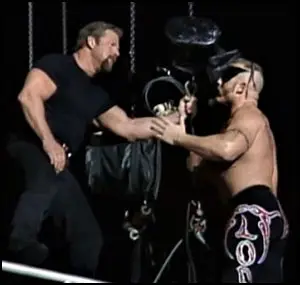 That became shockingly clear to WWF viewers during a controversial episode of Monday Night Raw when Hawk, who obviously appeared to be in an impaired condition, climbed to the top of the towering ‘Titan-Tron’ and, after accusing Animal of abandoning him, ‘fell’ from the top of the scaffolding in what appeared to be an on-air suicide attempt. It was eventually revealed to viewers that Hawk did, indeed, have a substance abuse problem but it was an envious, disingenuous Puke who had actually been his supplier. Weeks later, a clean & sober Hawk returned to WWF programming and confronted Puke before reuniting with his estranged partner Animal. The Legion of Doom, it seemed, was finally back. Yet, the reaction to the controversial storyline by fans (as well as Hawk and Animal themselves) was not positive and the angle was soon abandoned. By the Spring of 1999, the Legion of Doom had once again left the WWF, not on the best of terms with management, and the legendary duo would not return for nearly four years.
That became shockingly clear to WWF viewers during a controversial episode of Monday Night Raw when Hawk, who obviously appeared to be in an impaired condition, climbed to the top of the towering ‘Titan-Tron’ and, after accusing Animal of abandoning him, ‘fell’ from the top of the scaffolding in what appeared to be an on-air suicide attempt. It was eventually revealed to viewers that Hawk did, indeed, have a substance abuse problem but it was an envious, disingenuous Puke who had actually been his supplier. Weeks later, a clean & sober Hawk returned to WWF programming and confronted Puke before reuniting with his estranged partner Animal. The Legion of Doom, it seemed, was finally back. Yet, the reaction to the controversial storyline by fans (as well as Hawk and Animal themselves) was not positive and the angle was soon abandoned. By the Spring of 1999, the Legion of Doom had once again left the WWF, not on the best of terms with management, and the legendary duo would not return for nearly four years.
After departing the WWF, the Road Warriors made brief appearances in several different promotions, including major groups such as All Japan Pro Wrestling and TNA, as well as start-up leagues like the X.W.F., I.W.S., and various smaller independents. Away from the cameras, Mike Hegstrand was, thankfully, finally able to overcome his addictions during this time period, once and for all.
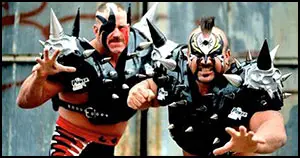 On May 12, 2003, Animal and Hawk made an unexpected surprise appearance on Raw and took on Kane and Rob Van Dam for the World Tag Team Championship. Although they didn’t come away with the title belts, the match (and, more specifically, the return of the Legion of Doom) was very well-received by WWE fans. However, for whatever reason, they were not offered a contract and their bout against Kane & Van Dam turned out to be the final WWE appearance for the Legion of Doom.
On May 12, 2003, Animal and Hawk made an unexpected surprise appearance on Raw and took on Kane and Rob Van Dam for the World Tag Team Championship. Although they didn’t come away with the title belts, the match (and, more specifically, the return of the Legion of Doom) was very well-received by WWE fans. However, for whatever reason, they were not offered a contract and their bout against Kane & Van Dam turned out to be the final WWE appearance for the Legion of Doom.
On October 19, 2003, the world of professional wrestling was shocked and saddened by the unexpected death of Road Warrior Hawk, Mike Hegstrand. The victim of a heart attack, Hegstrand was only 46 years old when he passed away. Following the unexpected death of his longtime partner and friend, Animal took some time off before returning to WWE in 2005. Once he was back in the promotion, Animal quickly formed a new tag team with the imposing John Heidenreich and on July 24, 2005, the menacing duo defeated M-N-M (Joey Mercury & Johnny Nitro) to win the WWE Tag Team championship. During their three months as champions, they continued their feud with M-N-M and briefly added valet Christy Hemme to the package before the new L.O.D. lost the championship back to M-N-M on October 28, 2005. The team continued on until January of 2006, when Heidenreich was released by World Wrestling Entertainment. Animal was repackaged as a singles performer, using his original name and persona, The Road Warrior, until he was also let go by WWE
Several months after leaving WWE, Animal resurfaced in All Japan Pro Wrestling on September 1, 2007, and made an immediate impact on the promotion when he teamed with Hawk’s former partner in The Hell Raisers, Kensuke Sasake. Known as The Hell Warriors, Animal Warrior & Power Warrior combined to make an impressive team that helped bring credibility and excitement to AJPW, which, at the time, was struggling both creatively and financially. The Hell Warriors also competed in Mexico, for the Toryumon Mexico promotion and on May 11, 2008, they defeated Damián el Terrible and Damián 666 to capture the U.W.A. World Tag Team championship at Toryumon’s Dragon-Mania event.
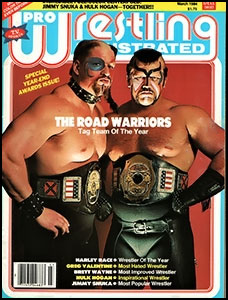 On March 1, 2011, Joe “Animal” Laurinaitis released his autobiography, The Road Warriors: Danger, Death, and the Rush of Wrestling. Co-written by William Andrew Wright, the insightful book delved deeply into the story of The Road Warriors from their beginning to the end and was received positively by fans and critics.
On March 1, 2011, Joe “Animal” Laurinaitis released his autobiography, The Road Warriors: Danger, Death, and the Rush of Wrestling. Co-written by William Andrew Wright, the insightful book delved deeply into the story of The Road Warriors from their beginning to the end and was received positively by fans and critics.
On September 9, 2020, Joe “the Road Warrior” Laurinaitis, passed away from natural causes in Osage Beach, Minnesota at the age of 60.
Hawk & Animal, the legendary Road Warriors, were voted Tag Team of the Year by the readers of Pro Wrestling Illustrated an unprecedented four different times between 1983-88. Additionally, they are members of the Wrestling Observer Newsletter’s Hall of Fame (1996), the WWE Hall of Fame (2011), the Professional Wrestling Hall of Fame & Museum (2011), the NWA Hall of Fame (2012), and the Quebec Wrestling Hall of Fame (2015).
by Stephen Von Slagle
Professional wrestling has always had more than its share of wild, larger-than-life ‘gimmick wrestlers’ or men who are known more for their ‘character’ than for their ability to perform inside of the ring. In many cases, the result has been embarrassing for both the wrestler and the sport. However, when the wrestler’s talent level is equal to the gimmick’s entertainment value, the result is almost always the emergence of a new wrestling superstar. And, without question, Ted Dibiase was one the most talented performers in wrestling during his nineteen years inside of the ring. The athletic second-generation grappler (both Dibiase’s father as well as his mother were professional wrestlers) burst onto the scene in the mid-Seventies and, almost immediately, he was pegged as a future NWA champion. Ultimately, he never wore the “ten pounds of gold.” However, with the aid of one of Vince McMahon’s greatest ideas, the former West Texas State lineman went on to transform himself into a character that will go down in the annals of wrestling history as one of the most successful and entertaining gimmicks ever; the cackling, money-grubbing, delightfully evil & sinfully wealthy Million Dollar Man.
The future Million Dollar Man was born on January 18, 1954, in Miami, Florida, the son of Ted Wills and Helen Nevins. His father was an entertainer and his mother built a career as a professional wrestler under the name Helen Hild. Hild competed during the Golden Age of Wrestling during the 1940s and 1950s and was a well-known attraction who wrestled against top-tier performers such as the renowned women’s World champion Mildred Burke as well as Burke’s successor, The Fabulous Moolah. Although his mother was a major professional wrestler, the story of The Million Dollar Man actually begins with another man by the name of Dibiase; “Iron” Mike Dibiase.
After splitting up with Ted Wills, Helen Nevins married Dibiase, who then adopted her young son as his own. For nearly two decades, “Iron” Mike was a popular fan favorite and a frequent champion during the middle portion of the twentieth century. A former national amateur champion at the University of Nebraska, the elder Dibiase also wore a version of the World Junior Heavyweight championship (precursor to today’s Cruiserweight or Light Heavyweight titles) and was well known by wrestling fans across the country. However, tragedy would strike the Dibiase family on a hot summer night in Lubbock, Texas. On July 2, 1969, the healthy, perpetually physically fit “Iron” Mike suffered a heart attack while performing a match and, tragically, died in the ring.
Ted Dibiase was just fifteen years old when his father passed away and, understandably, the death was a major blow to his family. But, despite the devastating loss of his dad, life went on and Dibiase attended high school at Creighton Prep in Omaha, Nebraska before going to West Texas State University on a football scholarship. However, due to an injury he suffered during his senior year, Dibiase made the decision to follow in his adoptive father’s footsteps and entered the wrestling business in 1974. An athlete of great natural ability, the 6’3″ 250 lb. Dibiase was trained initially by the Funk brothers and quickly graduated to the territorial circuit of the day.
 After learning the fundamentals in Texas, Dibiase began his career in the heartland of the country, wrestling for Bob Geigel’s Central States promotion and Sam Muchnick’s popular St. Louis-based group. Success came early for the young fan favorite and he soon won his first title, the Central States Heavyweight championship, from Drill Instructor Bob Slaughter (the future Sgt. Slaughter) on July 19, 1977. Dibiase scored another Central States title in January of 1978, and followed that win by also capturing the prestigious Missouri Heavyweight championship (often known as the ‘stepping stone to the NWA title’) a month later. It was as the Missouri champion that Dibiase began getting his first national write-ups in the wrestling magazines and the handsome young babyface quickly found himself in high demand across the country.
After learning the fundamentals in Texas, Dibiase began his career in the heartland of the country, wrestling for Bob Geigel’s Central States promotion and Sam Muchnick’s popular St. Louis-based group. Success came early for the young fan favorite and he soon won his first title, the Central States Heavyweight championship, from Drill Instructor Bob Slaughter (the future Sgt. Slaughter) on July 19, 1977. Dibiase scored another Central States title in January of 1978, and followed that win by also capturing the prestigious Missouri Heavyweight championship (often known as the ‘stepping stone to the NWA title’) a month later. It was as the Missouri champion that Dibiase began getting his first national write-ups in the wrestling magazines and the handsome young babyface quickly found himself in high demand across the country.
In 1979, just five years after entering the business, Dibiase was contacted by Vince McMahon, Sr. and brought into the World Wrestling Federation as the inaugural WWF North American champion. However, a few months after debuting his new championship, it came to McMahon’s attention that another North American title already existed in Bill Watts’ Mid South territory. With the wrestling business being what it was at that time, McMahon respectfully withdrew his “new” version of the North American title. Around this same time period, Pat Patterson defeated the young WWF North American champion for the title. Patterson then went on to enter his title into a “tournament” that was being held in Rio De Janeiro to determine the first Intercontinental champion. By virtue of his recent title win over Dibiase, Patterson represented North America and, in one of the biggest upsets in history, “won” the fictional tournament. Thus, the WWF I-C belt was born, while the short-lived WWF North American belt was forever buried.
It was also during this, his first WWF tenure, that Dibiase met and was defeated by a gargantuan young heel by the name of “The Incredible” Hulk Hogan in Hogan’s 1979 Madison Square Garden debut. While, at 6’3″ and weighing in at just under 250 pounds, Dibiase was big enough to handle himself against super-heavyweights, he was very much a scientific wrestler who relied on finesse and a solid repertoire of moves, not brute power. After gaining some seasoning in the Northeast, Dibiase traveled to the rugged Mid-South territory and once again became a North American champion, this time for promoter Bill Watts. After a successful run in Mid-South, Dibiase returned to Missouri and again captured the state’s Heavyweight title when he defeated Olympic weightlifter Ken Patera on November 21, 1980.
The national spotlight of TBS’s Georgia Championship Wrestling was next up for Dibiase and by this time he was a full-fledged superstar, one of the hottest young babyfaces the NWA had at the time, and slowly-but-surely he was being groomed to defeat Harley Race to become the new NWA champion. A controversial and very successful heel turn, first in Mid-South and a few months later in Georgia, proved that Dibiase could fulfill another requirement of any NWA World champion and truly work ‘both sides of the fence.’ However, due to a number of political factors and some plain old bad timing, Dibiase was never allowed to defeat Race for the NWA strap.
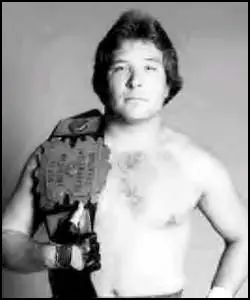 Ted Dibiase spent the first half of the Eighties traveling primarily between the Georgia, Missouri, and Mid-South territories, winning titles everywhere he stopped. Dibiase’s championship resume at this time included two National Tag Team championships and two National Heavyweight title reigns in Georgia, five Mid-South Tag Team titles and four North American Heavyweight titles in the Mid-South territory and two Missouri Heavyweight championships. He also forged a successful career in Japan wrestling for Shohei Baba’s All Japan Pro Wrestling, where he won the NWA United National championship as well as the PWF Tag Team title with partner Stan Hansen.
Ted Dibiase spent the first half of the Eighties traveling primarily between the Georgia, Missouri, and Mid-South territories, winning titles everywhere he stopped. Dibiase’s championship resume at this time included two National Tag Team championships and two National Heavyweight title reigns in Georgia, five Mid-South Tag Team titles and four North American Heavyweight titles in the Mid-South territory and two Missouri Heavyweight championships. He also forged a successful career in Japan wrestling for Shohei Baba’s All Japan Pro Wrestling, where he won the NWA United National championship as well as the PWF Tag Team title with partner Stan Hansen.
Although he’d been one of the most successful villains in the business, Dibiase eventually returned to the role of a babyface and with his lengthy heel turn long forgiven by his fans, he once again became one of the most popular fan favorites in the sport. Eventually, with the WWF’s expansion in full effect, Dibiase settled on Mid-South as his full-time base of operations. In order to compete with the ever-invading WWF, as well as Jim Crockett’s NWA group, Mid-South became the UWF, the Universal Wrestling Federation. Known for hard-hitting, non-stop action, the UWF set up a national syndication package and the regional group was eventually seen by wrestling fans nationwide.
The UWF, led by top babyfaces such as Dibiase, Steve Williams and Jim Duggan, as well as a roster of some of the best heels in the business at the time, quickly became known as the toughest promotion in wrestling, both on camera and off. However, when the UWF was eventually sold to Jim Crockett Promotions, Dibiase was lured away from another tenure with the NWA by an offer from Vince McMahon to enter the WWF with one of the promoter’s greatest gimmicks ever.
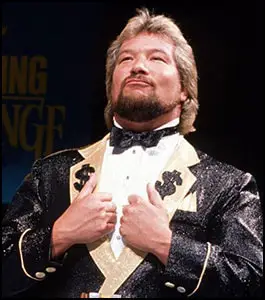 As the snickering, egotistical and downright evil Million Dollar Man, Dibiase quickly established himself as the Federation’s #1 ‘bad guy’ and WWF champion Hulk Hogan’s chief rival. Still one of the greatest scientific wrestlers to be found, Dibiase now had another ace up his sleeve; the fact that ‘everyone has a price’ and that The Million Dollar had the money to buy, literally, anything he wanted. Some of the WWF’s most entertaining vignettes involved Dibiase, whose character truly had a passion for humiliating and degrading ordinary people with his untold riches and bottomless savings account. With his silent, imposing bodyguard Virgil always by his side, Dibiase not only embraced being the wrestler that fans loved to hate but he also excelled at it, transforming himself into the quintessential pro wrestling heel.
As the snickering, egotistical and downright evil Million Dollar Man, Dibiase quickly established himself as the Federation’s #1 ‘bad guy’ and WWF champion Hulk Hogan’s chief rival. Still one of the greatest scientific wrestlers to be found, Dibiase now had another ace up his sleeve; the fact that ‘everyone has a price’ and that The Million Dollar had the money to buy, literally, anything he wanted. Some of the WWF’s most entertaining vignettes involved Dibiase, whose character truly had a passion for humiliating and degrading ordinary people with his untold riches and bottomless savings account. With his silent, imposing bodyguard Virgil always by his side, Dibiase not only embraced being the wrestler that fans loved to hate but he also excelled at it, transforming himself into the quintessential pro wrestling heel.
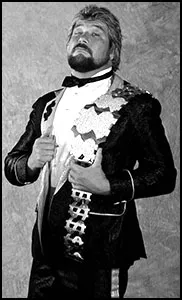 However, it was on February 5, 1988 that the legend of The Million Dollar Man was (arguably) born. On that evening, a national audience of over 33 million people tuned in to NBC (the first time one of the major networks had aired a pro wrestling event in nearly forty years) to see the WrestleMania III rematch of Hulk Hogan vs. Andre the Giant. Prior to the epic encounter, Dibiase had flatly stated on WWF programming that it didn’t matter who came out on top between Andre and The Hulk because he intended on simply buying the prized Heavyweight championship. After all, everyone has a price for the Million Dollar Man. History has since proven that what then took place was one of the most brilliant wrestling angles in the annals of professional wrestling. Twin referees, a bogus pin, the World Title wrongly changing hands — twice — and some of the most entertaining pro wrestling storytelling the world had ever seen. When “evil twin” ref Dave Hebner cost Hogan his belt, ending The Hulkster’s four-year-long first WWF title reign, with Dibiase then immediately trading Andre (and his manager, Bobby “The Brain” Heenan) a briefcase full of cash for the WWF strap, the fans in attendance, as well as those watching at home, were enraged.
However, it was on February 5, 1988 that the legend of The Million Dollar Man was (arguably) born. On that evening, a national audience of over 33 million people tuned in to NBC (the first time one of the major networks had aired a pro wrestling event in nearly forty years) to see the WrestleMania III rematch of Hulk Hogan vs. Andre the Giant. Prior to the epic encounter, Dibiase had flatly stated on WWF programming that it didn’t matter who came out on top between Andre and The Hulk because he intended on simply buying the prized Heavyweight championship. After all, everyone has a price for the Million Dollar Man. History has since proven that what then took place was one of the most brilliant wrestling angles in the annals of professional wrestling. Twin referees, a bogus pin, the World Title wrongly changing hands — twice — and some of the most entertaining pro wrestling storytelling the world had ever seen. When “evil twin” ref Dave Hebner cost Hogan his belt, ending The Hulkster’s four-year-long first WWF title reign, with Dibiase then immediately trading Andre (and his manager, Bobby “The Brain” Heenan) a briefcase full of cash for the WWF strap, the fans in attendance, as well as those watching at home, were enraged.
For a percentage of the wrestling fanbase, their anger stemmed from the fact that the highly theatrical spectacle was yet another example of how wrestling purists of the day felt Vince McMahon’s WWF was destroying the “sport” and turning it into a cartoonish circus. However, far more importantly, a much larger percentage of people were completely captivated by the shenanigans of Dibiase & Co. The debut episode of Saturday Night’s Main Event drew a huge rating for the WWF and NBC, easily eclipsing that of Saturday Night Live, which normally aired in S.N.M.E.’s time slot and was still one of NBC’s top programs at the time. Following the success of the debut episode, S.N.M.E. was a hit for the WWF & NBC for several more years to come, including another (highly rated) edition that featured Dibiase squaring off against Hogan one-on-one for the WWF championship.
Although it appeared that the impossible had truly happened and that Dibiase had, indeed, bought the Heavyweight title, the WWF refused to recognize his title claim, and the ramifications of that night on NBC led to WrestleMania IV, which featured a tournament for the held-up WWF championship. After defeating Jim Duggan and Don Muraco to advance to the finals of the tournament, Dibiase faced off against “Macho Man” Randy Savage and lost. Although fans of the day never knew it, Dibiase had actually been scheduled to win the WWF title against Savage, but, as had been the case in both the NWA and UWF previously, backstage politics ended up costing Dibiase his elusive World Title reign. Still, following his high-profile role in the main event of the inaugural S.N.M.E., The Million Dollar Man became a legitimate household name.
Over the following decade there were many twists & turns in the story of the Million Dollar Man, including a memorable run as the ‘Million Dollar Champion’ complete with his famously ostentatious diamond-studded title belt, as well as three WWF World Tag Team titles with fellow money-grubber Irwin R. Shyster. Even after the years and injuries finally took their toll and he was forced to retire in 1993, Dibiase still maintained a high profile and was an integral part of the World Wrestling Federation’s telecasts, both as the WWF’s top heel manager and, later, color commentator. But, as the WCW vs. WWF war began to heat up in the mid-Nineties, Dibiase, like so many other former WWF stars before him, eventually found his way to World Championship Wrestling and, more specifically, the promotion’s ultra-successful band of renegade heels known as the NWO, the New World Order.
With the arrival of “Trillionaire” Ted, the NWO’s new ‘financial advisor’, was further validation that the New World Order was, indeed, “taking over” and Dibiase was involved in several key WCW storylines during his three-year tenure with the Atlanta-based promotion. Eventually, though, he parted ways with the NWO, and became the babyface manager of multi-time NWA/WCW/WWF/New Japan World Tag Team champions Rick & Scott, the Steiner Brothers. After his run with The Steiners, Dibiase kept busy behind the scenes at WCW until he parted ways with the promotion in 1999.
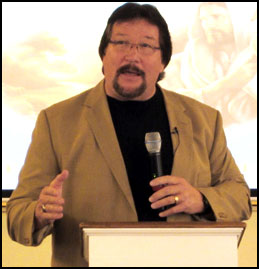 Following his retirement from wrestling, Dibiase vigorously pursued his new passion, that being religion. As a born-again Christian, Dibiase started his own ministry in 1999, founding the Heart of David Ministry and he began traveling across the country once again. This time, however, it was to churches and schools instead of sold-out wrestling arenas. And despite his strong personal beliefs, which often clashed with his former vocation, Dibiase found ways to occasionally return to his first love, most notable of which was his run as the color commentator for the short-lived, family-orientated W.X.O. syndicated wrestling program.
Following his retirement from wrestling, Dibiase vigorously pursued his new passion, that being religion. As a born-again Christian, Dibiase started his own ministry in 1999, founding the Heart of David Ministry and he began traveling across the country once again. This time, however, it was to churches and schools instead of sold-out wrestling arenas. And despite his strong personal beliefs, which often clashed with his former vocation, Dibiase found ways to occasionally return to his first love, most notable of which was his run as the color commentator for the short-lived, family-orientated W.X.O. syndicated wrestling program.
Then, in 2004, WWE offered DiBiase a job on their creative committee, where he spent the following year and a half helping to develop matches and storylines for WWE telecasts. Later, Dibiase was hired as a road agent for the Smackdown brand. In 2008, he introduced his talented son, Ted Dibiase, Jr., to the WWE audience and he was also involved in the wrestling careers of his two other sons, Mike and Brett Dibiase.
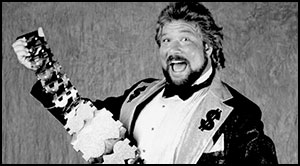 In September of 1997, while he was working for WCW, Dibiase released his autobiography, Every Man Has His Price, through Multnomah Publishers. After returning to WWE in 2004, the promotion re-released an updated version of the book on June 10, 2008. In the years since his return to WWE, Dibiase has been a reoccurring special guest on various programs and network specials, where he appeared both as himself and in-character as The Million Dollar Man.
In September of 1997, while he was working for WCW, Dibiase released his autobiography, Every Man Has His Price, through Multnomah Publishers. After returning to WWE in 2004, the promotion re-released an updated version of the book on June 10, 2008. In the years since his return to WWE, Dibiase has been a reoccurring special guest on various programs and network specials, where he appeared both as himself and in-character as The Million Dollar Man.
Ted Dibiase is a member of the Wrestling Observer Newsletter Hall of Fame (1996), the Professional Wrestling Hall of Fame (2007), the International Wrestling Institute & Museum’s George Tragos/Lou Thesz Professional Wrestling Hall of Fame (2007), the WWE Hall of Fame (2010), and the St. Louis Wrestling Hall of Fame (2014).
by Stephen Von Slagle
In the fickle world of pro wrestling, attention spans are short and stagnation is the key to damnation. In order to keep the fans’ attention, many wrestlers try outlandish gimmicks, adopt a flamboyant appearance or repeatedly switch from “bad guy” to “good guy”, sometimes all the above. Few wrestlers are able to maintain one identity or persona throughout their entire career without making the jump to “the other side of the fence,” be it as either a hero or a villain. Invariably, the ones who are able to pull it off are very special wrestlers and, without question, Ricky “The Dragon” Steamboat is truly one of those unique competitors.
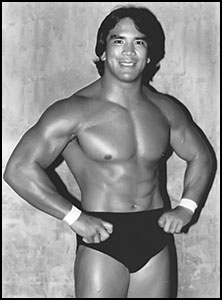 Steamboat is widely acknowledged as one of the best all-around performers of the late-twentieth century, an elite competitor whose raw talent, athleticism, and skill were nearly unparalleled in the business. He was also a consistently bankable draw for promoters, as well as a fan favorite in the truest sense of the term. As such, Steamboat became one of the most prolific champions of his era, capturing more than a dozen tag team titles, numerous secondary championships, and he was one of the fortuitous few to have won The Big One, the NWA World Heavyweight championship. A master technician inside of the squared circle, “The Dragon’s” repertoire, timing and ring psychology went virtually unequalled during his time in the sport and he stands in professional wrestling history alongside the literal best of the best.
Steamboat is widely acknowledged as one of the best all-around performers of the late-twentieth century, an elite competitor whose raw talent, athleticism, and skill were nearly unparalleled in the business. He was also a consistently bankable draw for promoters, as well as a fan favorite in the truest sense of the term. As such, Steamboat became one of the most prolific champions of his era, capturing more than a dozen tag team titles, numerous secondary championships, and he was one of the fortuitous few to have won The Big One, the NWA World Heavyweight championship. A master technician inside of the squared circle, “The Dragon’s” repertoire, timing and ring psychology went virtually unequalled during his time in the sport and he stands in professional wrestling history alongside the literal best of the best.
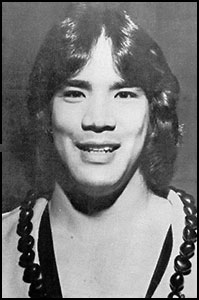 Ricky “The Dragon” Steamboat was born Richard Henry Blood on February 28, 1953 in West Point, New York. The oldest son of an American military serviceman and a Japanese mother, the Blood family moved frequently during Richard’s youth and the future Dragon attended high schools in both New York and Florida, where he excelled at wrestling. After graduating in 1971, the athletic Blood eventually found his way to Minnesota, where he enrolled in Verne Gagne’s professional wrestling training camp. Gagne’s AWA training camps were notoriously difficult and physically exhausting, intentionally designed to weed out those who Gagne felt were not qualified to make a career in pro wrestling. Richard Blood, however, was an exceptional athlete with a solid foundation in amateur wrestling, traits that Gagne highly valued. After completing the training camp, Blood made his professional debut in 1976, wrestling in the AWA under his real name. He then went on to compete in Gagne’s promotion for the majority of his rookie year before relocating back to his home state of Florida, where he wrestled for the legendary Eddie Graham. Upon his arrival in the territory, Graham, citing a strong resemblance to Sam Steamboat (who had been a popular attraction in Florida during the Sixties) gave Richard Blood a new ring-name; Rick Steamboat.
Ricky “The Dragon” Steamboat was born Richard Henry Blood on February 28, 1953 in West Point, New York. The oldest son of an American military serviceman and a Japanese mother, the Blood family moved frequently during Richard’s youth and the future Dragon attended high schools in both New York and Florida, where he excelled at wrestling. After graduating in 1971, the athletic Blood eventually found his way to Minnesota, where he enrolled in Verne Gagne’s professional wrestling training camp. Gagne’s AWA training camps were notoriously difficult and physically exhausting, intentionally designed to weed out those who Gagne felt were not qualified to make a career in pro wrestling. Richard Blood, however, was an exceptional athlete with a solid foundation in amateur wrestling, traits that Gagne highly valued. After completing the training camp, Blood made his professional debut in 1976, wrestling in the AWA under his real name. He then went on to compete in Gagne’s promotion for the majority of his rookie year before relocating back to his home state of Florida, where he wrestled for the legendary Eddie Graham. Upon his arrival in the territory, Graham, citing a strong resemblance to Sam Steamboat (who had been a popular attraction in Florida during the Sixties) gave Richard Blood a new ring-name; Rick Steamboat.
 After spending the first year of his career competing in the AWA and Florida promotions, Steamboat then entered the NWA’s Georgia territory and quickly became a popular undercard wrestler, paying his dues and working his way up the ladder. However, Georgia booker Ole Anderson soon realized that he did not have a good spot for the deserving Steamboat in his talent-rich promotion. As was commonplace during this territorial era of pro wrestling, Anderson contacted Mid-Atlantic booker George Scott and offered him the promising rookie, an offer that Scott accepted, forever changing Steamboat’s life. He burst upon the Mid-Atlantic scene in the Spring of 1977 and almost immediately scored an upset win over Mid-Atlantic TV champion Ric Flair on June 25, 1977. The surprise victory ignited what would go on to become one of professional wrestling’s greatest and longest-running feuds. Subsequently, the Crockett family’s popular Mid-Atlantic territory became Ricky Steamboat’s base of operations for the next eight years.
After spending the first year of his career competing in the AWA and Florida promotions, Steamboat then entered the NWA’s Georgia territory and quickly became a popular undercard wrestler, paying his dues and working his way up the ladder. However, Georgia booker Ole Anderson soon realized that he did not have a good spot for the deserving Steamboat in his talent-rich promotion. As was commonplace during this territorial era of pro wrestling, Anderson contacted Mid-Atlantic booker George Scott and offered him the promising rookie, an offer that Scott accepted, forever changing Steamboat’s life. He burst upon the Mid-Atlantic scene in the Spring of 1977 and almost immediately scored an upset win over Mid-Atlantic TV champion Ric Flair on June 25, 1977. The surprise victory ignited what would go on to become one of professional wrestling’s greatest and longest-running feuds. Subsequently, the Crockett family’s popular Mid-Atlantic territory became Ricky Steamboat’s base of operations for the next eight years.
The athletic young Steamboat went on to hold the Mid-Atlantic TV Title for four months before being defeated by the hated Baron Von Raschke on October 15, 1977. The title loss was somewhat mitigated, however, due to the fact that Steamboat and Paul Jones had won the Mid-Atlantic Tag Team title less than a month earlier, on August 22, 1977. Steamboat & Jones defeated the young and vicious team of Ric Flair & Greg Valentine for the championship belts, further inflaming Flair and Steamboat’s heated rivalry. Arguably the two brightest young stars in wrestling at the time, their feud quickly became the red-hot Mid-Atlantic territory’s most profitable match-up and the two young ring warriors battled each other virtually every night of the week. The stakes of their rivalry were raised even higher when Steamboat closed the year by defeating Flair for the region’s top prize, the prestigious United States Heavyweight title, on November 1, 1977. His first year in the Mid-Atlantic territory (and only his second full year in the wrestling business) had been an unprecedented success and while 1977 was truly a breakout year for Ricky Steamboat, 1978 proved to be even better…
On April 23, 1978 Steamboat & Jones, the reigning Mid-Atlantic Tag Team champs, captured the NWA World Tag Team titles by winning a 10-team tournament, becoming dual champions and one of the top teams in the sport. Still, as time went on it became apparent to fans that Jones was jealous of the young, handsome Steamboat and all of the attention that he received. Jones eventually turned violently on Steamboat and the two former partners engaged in a bitter series of grudge matches, with Steamboat coming out on top of the feud with his former mentor. Once he had disposed of Jones, Steamboat’s attention was once again turned to his arch-rival, “Nature Boy” Ric Flair, and on December 18, 1978 he once again defeated Flair for the prestigious United States championship. However, as time would tell, Flair and Steamboat were very evenly matched opponents and “Slick” Ric rebounded to defeat Steamboat on April 1, 1979 and regain his U.S. Heavyweight championship.
Filled with talent and ambition, even in defeat Rick Steamboat would invariably bounce back from a championship loss by simply going out and winning another title. On October 24, 1979, he and Jay Youngblood teamed to win their first NWA World Tag Team championship and, all total, the gifted young team of Steamboat & Youngblood won the World Tag Team championship on five different occasions. Additionally, he also captured the Mid Atlantic Tag Team title with Youngblood in Toronto on August 22, 1982. In the ring, Steamboat and Youngblood were truly exceptional and their individual styles meshed perfectly with one another during their five-year tenure as a tag team. However, away from the spotlight, differences in lifestyle and personal choices slowly formed cracks in the foundation of their inspired partnership, eventually leading to its disintegration. On Christmas Day 1983, Steamboat & Youngblood’s NWA World Tag Team title was vacated when Steamboat announced his intention to retire from the sport in order to spend more time with his family. While Steamboat’s “retirement” did not last even a full year, the talented and extremely popular duo would never team again, as Jay Youngblood (Steven Romero) tragically died on September 2, 1985. At the time of his death, Youngblood was just thirty years old. During their five-year run as a tag team, Steamboat & Youngblood were either the Mid-Atlantic or NWA World Tag Team champions for a total of 543 days, a truly impressive accomplishment for what turned out to be one of pro wrestling’s greatest unsung tag teams.
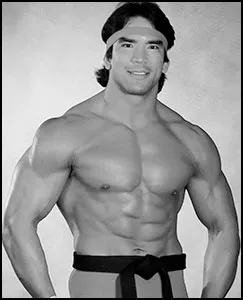 After spending nearly a decade as Mid-Atlantic Wrestling’s purest babyface, Steamboat, having accomplished essentially every goal possible in the territory (while also experiencing creative differences with new Mid-Atlantic booker Dusty Rhodes) showed up in the World Wrestling Federation in the Fall of 1985. Upon his debut, Rick Steamboat adopted a martial arts persona and was billed as Ricky “The Dragon” Steamboat. As had been the case in the NWA, Steamboat continued his winning ways and quickly established himself as one of the premier wrestlers in the WWF. During his first run in the World Wrestling Federation, Steamboat entered into violent, intense, main-event feuds with the likes of “Magnificent” Don Muraco, Jake “The Snake” Roberts, and, of course, “Macho Man” Randy Savage. It was against Savage that Steamboat engaged in perhaps the hottest WWF rivalry at the time, culminating in what many still claim to be the greatest match in Wrestlemania history. On March 29, 1987, after a truly classic battle, Steamboat pinned Savage in front of nearly 80,000 fans to win the WWF Intercontinental Heavyweight title at WrestleMania III.
After spending nearly a decade as Mid-Atlantic Wrestling’s purest babyface, Steamboat, having accomplished essentially every goal possible in the territory (while also experiencing creative differences with new Mid-Atlantic booker Dusty Rhodes) showed up in the World Wrestling Federation in the Fall of 1985. Upon his debut, Rick Steamboat adopted a martial arts persona and was billed as Ricky “The Dragon” Steamboat. As had been the case in the NWA, Steamboat continued his winning ways and quickly established himself as one of the premier wrestlers in the WWF. During his first run in the World Wrestling Federation, Steamboat entered into violent, intense, main-event feuds with the likes of “Magnificent” Don Muraco, Jake “The Snake” Roberts, and, of course, “Macho Man” Randy Savage. It was against Savage that Steamboat engaged in perhaps the hottest WWF rivalry at the time, culminating in what many still claim to be the greatest match in Wrestlemania history. On March 29, 1987, after a truly classic battle, Steamboat pinned Savage in front of nearly 80,000 fans to win the WWF Intercontinental Heavyweight title at WrestleMania III.
 Yet, after nearly two years of working towards a title win in the WWF, the newly-crowned Intercontinental champion was anti-climatically defeated less than three months later in a controversial match against the far less competent Honkytonk Man. Unbeknownst to WWF fans at the time, Steamboat’s I-C title reign was cut short due to a conflict with Vince McMahon regarding time he had requested off prior to winning the championship. As a result, he was asked to drop the title and, upon his return several months later, there was a dramatic decrease in both the quality of Steamboat’s opponents and his placement on house show and p.p.v. events. The writing was clearly on the wall and by the Summer of 1988, Steamboat had left the World Wrestling Federation.
Yet, after nearly two years of working towards a title win in the WWF, the newly-crowned Intercontinental champion was anti-climatically defeated less than three months later in a controversial match against the far less competent Honkytonk Man. Unbeknownst to WWF fans at the time, Steamboat’s I-C title reign was cut short due to a conflict with Vince McMahon regarding time he had requested off prior to winning the championship. As a result, he was asked to drop the title and, upon his return several months later, there was a dramatic decrease in both the quality of Steamboat’s opponents and his placement on house show and p.p.v. events. The writing was clearly on the wall and by the Summer of 1988, Steamboat had left the World Wrestling Federation.
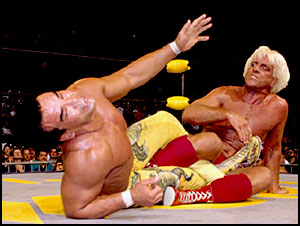 Meanwhile, back in the National Wrestling Alliance, Eddie Gilbert was in the midst of a minor TV feud with Ric Flair and the Four Horsemen in January of 1989 when he announced that he would have a surprise partner to face Ric Flair and Barry Windham for a match on an upcoming episode of World Championship Wrestling. The arrogant Flair was unimpressed and clearly not expecting much when, from out of nowhere, Ricky Steamboat, Flair’s greatest enemy, appeared on TBS and actually pinned the stunned NWA champion in front of the whole nation. Forced into a title match by the NWA Board of Directors, Flair then lost his cherished World Heavyweight championship to Steamboat on February 20, 1989, in Chicago, Illinois. The new champion went on to retain his title in a series of rematches against Flair and, later, defended the NWA World championship against other Top Ten contenders like The Iron Sheik and Butch Reed at live arena events across the country. But Flair, as always, could not be counted out and 76 days after losing the title belt, the Nature Boy regained his World championship by defeating Steamboat in Nashville at the NWA’s 1989 “WrestleWar: Music City Showdown” pay-per-view. Not long afterwards, Steamboat and the NWA were unsuccessful in agreeing to a new contract and, excluding a short yet exciting tour of New Japan during the Fall of 1990, The Dragon once again disappeared from the wrestling world.
Meanwhile, back in the National Wrestling Alliance, Eddie Gilbert was in the midst of a minor TV feud with Ric Flair and the Four Horsemen in January of 1989 when he announced that he would have a surprise partner to face Ric Flair and Barry Windham for a match on an upcoming episode of World Championship Wrestling. The arrogant Flair was unimpressed and clearly not expecting much when, from out of nowhere, Ricky Steamboat, Flair’s greatest enemy, appeared on TBS and actually pinned the stunned NWA champion in front of the whole nation. Forced into a title match by the NWA Board of Directors, Flair then lost his cherished World Heavyweight championship to Steamboat on February 20, 1989, in Chicago, Illinois. The new champion went on to retain his title in a series of rematches against Flair and, later, defended the NWA World championship against other Top Ten contenders like The Iron Sheik and Butch Reed at live arena events across the country. But Flair, as always, could not be counted out and 76 days after losing the title belt, the Nature Boy regained his World championship by defeating Steamboat in Nashville at the NWA’s 1989 “WrestleWar: Music City Showdown” pay-per-view. Not long afterwards, Steamboat and the NWA were unsuccessful in agreeing to a new contract and, excluding a short yet exciting tour of New Japan during the Fall of 1990, The Dragon once again disappeared from the wrestling world.
After a fairly long period of time away from his fans in North America, Steamboat again reappeared in the WWF in February of 1991. However, unlike his previous WWF tenure, lingering tensions between Vince McMahon and Steamboat ensured that this time around, the former Intercontinental champion would be relegated to lower mid-card matches and feuds.
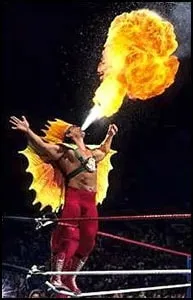
He was billed only as “The Dragon” during this WWF tour, and the main thrust of his character was an impressive pre-match ritual that saw The Dragon breathe fire. Yet, despite the heat generated by his new entrance, he was placed on a treadmill of lower-card matches and was fed clearly inferior opponents. This treatment wasn’t satisfactory to Steamboat, who was truly one of wrestling’s elite names, and following a rather bland run of being misused in the WWF, he once again left the Federation after less than a year in the promotion.
Not long after departing the WWF, Steamboat reappeared in WCW and, as had been the case a few years prior, he once again did so in a dramatic and unexpected fashion. When Dustin Rhodes’ partner Barry Windham was injured by the reigning WCW World Tag Team champions, The Enforcers (Arn Anderson & Larry Zbyszko), “The Natural” was forced to find a new partner for a scheduled title match at the upcoming The Clash of the Champions broadcast. On the night of the match, Rhodes’ “mystery partner” was revealed in dramatic fashion to be the returning Dragon and Steamboat & Rhodes then went on to defeat the stunned Enforcers to capture the WCW World Tag Team titles on November 19, 1991. The popular new champions went on to defend their title belts for nearly three months before being dethroned by Paul E. Dangerously’s duo of Arn Anderson & Bobby Eaton.
From there, The Dragon began feuding with members of The Dangerous Alliance faction, in particular, reigning U.S. Heavyweight champion “Ravishing” Rick Rude. At the time, Rude was arguably the top heel not only in WCW but the entirety of professional wrestling and his matches with the ultra-talented Steamboat were among the most exciting in the sport during this time period. Following his exceptional series with Rude, Steamboat entered into a program with another supremely gifted opponent from Paul E.’s Dangerous Alliance, “Stunning” Steve Austin. Steamboat and Austin feuded for months in WCW, providing TBS with high television ratings and the viewers with truly exemplary matches. The lengthy and exciting Steamboat-Austin feud culminated with The Dragon taking “Stunning” Steve’s World TV championship on September 2, 1992.
Exactly 364 days after his return to WCW, Steamboat teamed with a young Shane Douglas to once again win the WCW World Tag Team championship on November 18, 1992. This marked The Dragon’s eighth (and final) reign as one-half of the World Tag Team champions and the seemingly make-shift duo instantly gelled into an elite-level team. Steamboat and Douglas’ combination of experience & youth, agility & speed, and technique & athleticism synthesized into a truly great, albeit somewhat overlooked, tag team and one of the best babyface combos in WCW’s thirteen-year history. Over the course of the following four months, Steamboat & Douglas defended their belts before eventually losing to another great, unsung team from the early Nineties, Steve Austin & Brian Pillman, known collectively as The Hollywood Blondes.
On August 18, 1993 “The Dragon” once again won a major championship, this time the WCW World TV title. After defeating “Mr. Wonderful” Paul Orndorff in Daytona Beach, Florida, Steamboat went on to defend his World TV championship against all comers each week on WCW’s cable & syndicated programs. During his four reigns as the NWA/WCW World TV champion, Steamboat held the title for a combined 314 days, establishing himself as one of the greatest titleholders in the long history of the championship. Steamboat also became a four-time NWA/WCW United States champion by defeating “Stunning” Steve Austin for the belt on August 24, 1994. Reigniting their exciting feud from 1992, the two talented athletes picked up right where they’d left off, thrilling fans with a new round of exceptional bouts. However, Steamboat suffered a legitimate back injury while wrestling Austin and was forced to vacate the championship on September 18, 1994, less than a month after his championship victory. It was the last title Rick Steamboat ever held, as his injury was severe enough that he was forced to retire from professional wrestling after nineteen years in the sport. WCW President Eric Bischoff then literally added insult to injury when he unceremoniously fired Steamboat weeks later, via Federal Express.
For nearly a decade, Steamboat remained away from the spotlight, enjoying life as a husband, father and small business owner. In 2002, though, he returned to the world of professional wrestling as a guest referee and ambassador of sorts for the upstart TNA promotion. Steamboat later joined Ring of Honor, where he was involved in an ongoing storyline with R.O.H. Pure Wrestling champion C.M. Punk. The Dragon also worked a program in R.O.H. with Mick Foley that never actually resulted in a return to the ring for Steamboat, yet provided several entertaining interview segments. Having made his way back into the sport, albeit in a limited capacity, it was no real surprise when Ricky Steamboat returned to WWE in 2005, the first time he’d done so in over a dozen years, taking on a job as a producer as well as making occasional guest appearances on television and pay-per-view events.
Several years later, during the build-up for WrestleMania XXV, the next logical step in the return of Ricky Steamboat took place when he became part of a storyline involving Chris Jericho. The former “Ayatollah of Rock ‘n Rolla” was now portraying a far more serious and sinister role, one in which he was intent on proving his greatness by destroying past icons and legends of the sport. Along with “Rowdy” Roddy Piper and Jimmy “Superfly” Snuka, a 56 year-old Steamboat climbed back into the ring at a sold-out Reliant Stadium in Houston, Texas to face Jericho in a three-on-one handicap match. Although he had not wrestled in some fifteen years, The Dragon carried the load for his team and showed signs of his former brilliance before ultimately going down in defeat to Jericho. Although he came out on the losing end of the unique encounter, Steamboat was so impressive during his WrestleMania XXV appearance that the promotion scheduled a rematch against Jericho for the following month’s pay-per-view, Backlash. Encouraged by his ability to still perform at a high level, The Dragon teamed up with his young son Richie Steamboat in 2009 for the Puerto Rican-based World Wrestling Council and again in 2010 while the younger Steamboat was competing in the WWE developmental territory, Florida Championship Wrestling.
While a full-time return to wrestling was never his goal, the matches with Richie and his encounters with Jericho (as well as the outpouring of positive fan reaction that accompanied each of his appearances in the ring) were more than enough to prove that Ricky “The Dragon” Steamboat still had plenty of gas left in the tank. Another storyline was then developed in which Steamboat would face off against WWE’s newest heel faction, The Nexus. On the June 28, 2010 edition of Monday Night Raw, Steamboat was on hand to promote the release of his new DVD, Ricky Steamboat: The Life Story of the Dragon, when he was attacked by the youthful group of villains. The storyline called for Steamboat to suffer debilitating injuries at the hands of The Nexus, and it was reported on the WWE website that Steamboat had been hospitalized following the televised beat-down. However, as is often the case in professional wrestling, life imitates art. Within days it was revealed that during the angle with The Nexus, Steamboat had actually legitimately been hospitalized after re-injuring his back, the same problem area that had caused his original retirement back in 1994.
 With the real possibility of paralysis should he ever compete again, Steamboat permanently retired from in-ring action following his brief but impressive return. He then went on to serve as an NXT trainer for the next several years until his son Richie was released from his development contract in 2013. Although he is no longer an employee of WWE, Steamboat has continued making occasional guest appearances for the promotion.
With the real possibility of paralysis should he ever compete again, Steamboat permanently retired from in-ring action following his brief but impressive return. He then went on to serve as an NXT trainer for the next several years until his son Richie was released from his development contract in 2013. Although he is no longer an employee of WWE, Steamboat has continued making occasional guest appearances for the promotion.
Ricky “The Dragon” Steamboat is a member of the Wrestling Observer Newsletter Hall of Fame (1996), the Professional Wrestling Hall of Fame (2002), the WWE Hall of Fame (2009), the International Wrestling Institute & Museum’s George Tragos/Lou Thesz Professional Wrestling Hall of Fame (2009), and the NWA Hall of Fame (2012).
by Stephen Von Slagle
Throughout the long and storied history of professional wrestling, there have always been certain performers who, despite never winning the World Heavyweight championship or enjoying a ten-year run as a promotion’s top wrestler, greatly impacted the business as a whole by profoundly influencing the following generation of wrestling superstars. Without question, one legend of the ring who falls into this special category is the risk-taking, high-flying yet incredibly powerful native of the Fiji Islands, the legendary “Superfly” Jimmy Snuka. A performer who was undoubtedly one of the most popular babyfaces of his era and a genuine box-office attraction, the versatile Snuka was also a very believable, effective and dangerous heel who was involved in bitter feuds with some of the biggest names in pro wrestling. Yet, while his legendary career spanned over forty years, The Superfly unquestionably made his biggest impact during his prime in the late Seventies and early-mid Eighties, when his innovative, dare-devilish wrestling style served as the blueprint for many future ring aerialists.
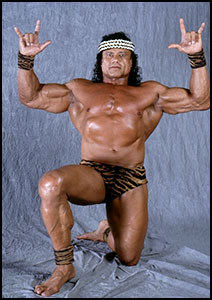 For more than a quarter century, The Superfly was a major player within the wrestling business and during his prime, he was among the sport’s elite names and biggest draws at the box office. Additionally, through his unique combination of agility, speed and strength, not to mention his spectacular arsenal of high-flying, high-impact moves, the dare devilish “Superfly” Jimmy Snuka genuinely helped reshape the look of professional wrestling. As a result of his constant travelling and high-profile match-ups, the muscular aerialist had an undeniable influence on a diverse collection of top performers, from Kevin Von Erich to Mick Foley, Sabu to The Hardy Boyz, and Chris Benoit to Rey Mysterio among others.
For more than a quarter century, The Superfly was a major player within the wrestling business and during his prime, he was among the sport’s elite names and biggest draws at the box office. Additionally, through his unique combination of agility, speed and strength, not to mention his spectacular arsenal of high-flying, high-impact moves, the dare devilish “Superfly” Jimmy Snuka genuinely helped reshape the look of professional wrestling. As a result of his constant travelling and high-profile match-ups, the muscular aerialist had an undeniable influence on a diverse collection of top performers, from Kevin Von Erich to Mick Foley, Sabu to The Hardy Boyz, and Chris Benoit to Rey Mysterio among others.
Jimmy “Superfly” Snuka was born James Reiher in 1943 in Suva, Fiji, and the muscular South Pacific islander began his wrestling career in 1970. Prior to getting into the wrestling business, Snuka enjoyed a successful career as a bodybuilder; Mr. Hawaii, Mr. Waikiki and Mr. North Shore were among the titles he won while competing in the sport. As a result of working out regularly at pro wrestler Dean Ho’s gym in Hawaii, Snuka came into contact with many of the wrestlers who worked in the South Pacific region and, eventually, he decided to explore his options in the business. Following his initial training by the legendary Danny Hodge, he worked throughout the Hawaiian islands as Jimmy Kealoha (among other temporary ring-names) until the potential-filled newcomer settled in the NWA’s Oregon-based Pacific Northwest territory during the early Seventies. Almost immediately, the popular high-flyer from Fiji became a staple of the territory and he enjoyed a great deal of success (as well as gaining valuable ring experience) in the northwestern promotion. Additionally, it was during his run in P.N.W. that Snuka engaged in his first major feud, a program that would run for more than two years, against another promising young up-and-comer, Jesse Ventura.
In terms of championship gold, Jimmy Snuka’s run in Don Owen’s territory was highly successful, especially for someone so new to the business; he wore the NWA Pacific Northwest Heavyweight title a total of six times between 1973 through 1977, defeating the likes of Bull Ramos, Ripper Collins, Black Angus and Jesse Ventura for the prestigious regional championship. As if his numerous singles championship victories were not impressive enough, the young Snuka was equally successful in the tag team ranks and he formed a team with Dutch Savage that was one of the most dominant in the long history of the NWA’s Pacific Northwest territory. Together, the team of Snuka & Savage won the region’s tag team championship on six separate occasions between 1973 through 1978, toppling Pacific Northwest championship duos such as Bull Ramos & Ripper Collins, Ramos & Hussein Arab (The Iron Sheik) and Jesse Ventura & Buddy Rose along the way.
After a few years of competing in the Pacific Northwest territory, Snuka eventually expanded his base of operations and began splitting his time between Oregon and other NWA territories. While wrestling in the neighboring Vancouver territory, Snuka teamed with the legendary Don Leo Jonathan to win the NWA Canadian Tag Team Title on April 12, 1976. Additionally, Snuka (who had already begun using his famous, spectacular flying body splash as his signature move) began appearing in Texas and the muscular, bare-footed high-flyer became one of promoter Paul Bosch’s top draws. While wrestling in Bosch’s Houston-based promotion, the popular Superfly captured the prestigious Texas Heavyweight title (by defeating Scott Casey) and also the Texas Tag Team title (with partner Gino Hernandez), both in 1977.
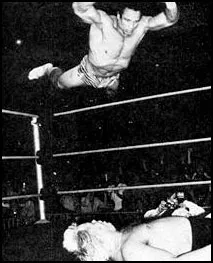 Next up for Snuka was the Mid-Atlantic region, which was virtually overflowing with future superstars who were just a few years away from becoming household names, including Ric Flair, Greg Valentine, Rick Steamboat, Paul Orndorff and Dino Bravo among many others. Shortly after entering the territory, Snuka formed a team with another popular and muscular young newcomer, Paul Orndorff, and together they won the NWA World Tag Team Title in December of 1978 by defeating Baron Von Raschke & Greg Valentine. Much like the Mid-Atlantic territory itself, the team of Snuka & Orndorff combined youth, power & athleticism and the two enjoyed the full support of the region’s fans. However, despite their popularity and talent, their reign as the World champions eventually came to an end when they were defeated by the team of Von Raschke & Paul Jones. Yet, despite being one of the most popular wrestlers in the region, it eventually became apparent to the viewers (in a rather shocking manner) that Snuka believed he had been overlooked by the fans and “lied” to by the promotion’s top fan favorites. As a result, the once beloved Superfly transformed himself, virtually overnight, into one of the most vicious and despised performers in the history of the Mid-Atlantic territory. Additionally, he took on the (then) hated former World champion-turned-manager, “Nature Boy” Buddy Rogers, as his new mentor. The pairing of the ruthless former champ and his powerful & unpredictable young protégé was a truly formidable, money-drawing duo that immediately established themselves as the region’s most hated performers.
Next up for Snuka was the Mid-Atlantic region, which was virtually overflowing with future superstars who were just a few years away from becoming household names, including Ric Flair, Greg Valentine, Rick Steamboat, Paul Orndorff and Dino Bravo among many others. Shortly after entering the territory, Snuka formed a team with another popular and muscular young newcomer, Paul Orndorff, and together they won the NWA World Tag Team Title in December of 1978 by defeating Baron Von Raschke & Greg Valentine. Much like the Mid-Atlantic territory itself, the team of Snuka & Orndorff combined youth, power & athleticism and the two enjoyed the full support of the region’s fans. However, despite their popularity and talent, their reign as the World champions eventually came to an end when they were defeated by the team of Von Raschke & Paul Jones. Yet, despite being one of the most popular wrestlers in the region, it eventually became apparent to the viewers (in a rather shocking manner) that Snuka believed he had been overlooked by the fans and “lied” to by the promotion’s top fan favorites. As a result, the once beloved Superfly transformed himself, virtually overnight, into one of the most vicious and despised performers in the history of the Mid-Atlantic territory. Additionally, he took on the (then) hated former World champion-turned-manager, “Nature Boy” Buddy Rogers, as his new mentor. The pairing of the ruthless former champ and his powerful & unpredictable young protégé was a truly formidable, money-drawing duo that immediately established themselves as the region’s most hated performers.
Under the tutelage of the original “Nature Boy,” Snuka defeated his new arch-rival and the territory’s #1 babyface, Rick Steamboat, in a tournament to fill the vacated United States Heavyweight championship. Having defeated Steamboat for the prestigious title on September 1, 1979, Snuka maintained an ironclad grip on the U.S. belt for nearly eight full months. At the same time, the rule-breaking Superfly was defending his championship against some very capable challengers, including Steamboat, the massive 6′ 8″ 320 lb. Blackjack Mulligan and other top Mid Atlantic babyfaces. During The Superfly’s reign as the United States champion, his unique combination of speed and cat-like agility mixed with his nearly limitless strength and a genuinely vicious mean streak truly gelled, with Snuka emerging as one of the most intimidating and dangerous heels of the era.
Other than Rick Steamboat, the primary challenger for Jimmy Snuka’s United States belt was a man who had, ironically enough, been the region’s previous top heel, the controversial and flamboyant “Nature Boy” Ric Flair. Although he had once been the most reviled man in the territory, by the time he engaged in his bitter, bloody feud with Snuka, “Slick” Ric had undergone a transformation that resulted in him becoming the most popular wrestler in the promotion. As a result of their standing as the two top men in the territory, not to mention the great talent possessed by each highly gifted wrestler, the Snuka-Flair matchup was a natural moneymaker and the Nature Boy’s chase after Snuka’s U.S. gold (which concluded when Flair won the title on April 19, 1980) was the Mid-Atlantic’s primary storyline for several months. Then, when Buddy Rogers left the promotion, Snuka was paired with a new manager in Gene Anderson and the former leader of the Minnesota Wrecking Crew immediately teamed his newest find with the rugged veteran Ray “The Crippler” Stevens. Under the guidance of Anderson, Snuka & Stevens quickly formed a superior tag team that steamrolled over every team placed before them. Not surprisingly, they soon earned a series of matches against the popular multi-time World Tag Team champions, Rick Steamboat & Jay Youngblood. While the experienced, talented duo of Steamboat & Youngblood was initially able to turn back the challenge of Snuka & Stevens, the champions eventually fell to Anderson’s lethal team on June 22, 1980. Although their styles were not terribly similar, Snuka & Stevens combined to make a devastating team and they held their World Tag Team championship for nearly a half-year before finally losing the straps to the duo of The Masked Superstar & Paul Jones in Greensboro, North Carolina.
 Having been a main player in the Mid-Atlantic territory for nearly five years, and after battling virtually every top fan favorite in the region, The Superfly made his next career move when he became involved in one of the biggest feuds of the day, one that was taking place in the wrestling hotbed of Atlanta, Georgia. In the summer of 1981, Michael Hayes and Terry Gordy, two-thirds of the incredibly successful team known as the Fabulous Freebirds, were in the midst of a bitter falling out that had escalated into an all-out war between the two former teammates. Enter The Superfly. When Snuka appeared, completely unexpectedly, as Gordy’s new partner it became clear immediately that the highly talented Superfly was not to be taken lightly. Furthermore, with the arrival of the ultra-violent Jimmy Snuka as Gordy’s new partner, it was apparent that Hayes, who had alienated himself from the territory’s pool of babyfaces, was a marked man, indeed. Meanwhile, without a duo able to match their combination of strength, skill and violence, the team of Snuka & Gordy quickly captured the region’s top prize, the National Tag Team championship, on July 6, 1981 by defeating the reigning champs, Ted Dibiase & Steve Olsonowski in Augusta, Georgia. At the same time, the rugged and talented duo continued their two-on-one war against Michael Hayes. Two-on-one, that is, until Hayes enlisted the (substantial) aid of the seven-foot, five hundred pounder known as Otis Sistrunk. In the lovable and truly gargantuan hillbilly, Hayes finally found his equalizer and on September 27, 1981, the unlikely duo of Hayes & Sistrunk ended Snuka & Gordy’s nearly four-month reign as the National Tag Team champions.
Having been a main player in the Mid-Atlantic territory for nearly five years, and after battling virtually every top fan favorite in the region, The Superfly made his next career move when he became involved in one of the biggest feuds of the day, one that was taking place in the wrestling hotbed of Atlanta, Georgia. In the summer of 1981, Michael Hayes and Terry Gordy, two-thirds of the incredibly successful team known as the Fabulous Freebirds, were in the midst of a bitter falling out that had escalated into an all-out war between the two former teammates. Enter The Superfly. When Snuka appeared, completely unexpectedly, as Gordy’s new partner it became clear immediately that the highly talented Superfly was not to be taken lightly. Furthermore, with the arrival of the ultra-violent Jimmy Snuka as Gordy’s new partner, it was apparent that Hayes, who had alienated himself from the territory’s pool of babyfaces, was a marked man, indeed. Meanwhile, without a duo able to match their combination of strength, skill and violence, the team of Snuka & Gordy quickly captured the region’s top prize, the National Tag Team championship, on July 6, 1981 by defeating the reigning champs, Ted Dibiase & Steve Olsonowski in Augusta, Georgia. At the same time, the rugged and talented duo continued their two-on-one war against Michael Hayes. Two-on-one, that is, until Hayes enlisted the (substantial) aid of the seven-foot, five hundred pounder known as Otis Sistrunk. In the lovable and truly gargantuan hillbilly, Hayes finally found his equalizer and on September 27, 1981, the unlikely duo of Hayes & Sistrunk ended Snuka & Gordy’s nearly four-month reign as the National Tag Team champions.
Next up for the nomadic aerialist was to test his skills against the top Asian competitors and The Superfly embarked on his first tour of All Japan Pro Wrestling in the Fall of 1981. Once there, the high-flying brawler greatly impressed the Japanese audiences and in addition to excelling in the AJPW singles ranks, Snuka formed a legitimate dream team with legendary wildman Bruiser Brody. As had been the case with his other partners, when The Superfly teamed up with Bruiser Brody, Fiji’s most famous son once again became one-half of a truly remarkable tag team. Snuka & Brody’s overwhelming size and strength alone was more than most teams could handle. Yet, when you factor in both men’s superlative brawling abilities and the fluidity of their teamwork, one begins to realize just how great of a team they made during their time in All Japan and, later, New Japan. In December of 1981, Snuka & Brody overcame a formidable series of opponents to win All Japan Pro Wrestling’s annual Real World Tag Team tournament. Several years later, following both men’s jump to New Japan, the barbaric yet highly skilled duo steamrolled over their competition en route to the finals of the inaugural I.W.G.P. World Tag Team tournament, where they would face the team of Inoki and Sakaguchi. True to form, though, the unpredictable Snuka & Brody no-showed the event, which enabled their replacements, Tatsumi Fujinami & Kengo Kimura, to become the first-ever I.W.G.P. World Tag Team champions on December 12, 1985.
In 1982, following months of speculation that he would join the promotion, Jimmy “Superfly” Snuka entered the World Wrestling Federation. Under the guidance of manager Captain Lou Albano, the lethal Superfly systematically overcame each challenger as he quickly rose to the top of the WWF rankings. At the same time, he greatly impressed the region’s fans, who had not seen such spectacular moves by a man so agile since the legendary Mil Mascaras. Unlike the noble Mascaras, though, Snuka portrayed himself as a bloodthirsty savage, albeit a very talented one, and he was perhaps the most feared rulebreaker in the WWF during this period of time. Meanwhile, the desired end result of Snuka and Albano’s rampage was clear; a title shot against WWF champion Bob Backlund. In the powerful, agile, vicious and completely unpredictable Jimmy “Superfly” Snuka, Bob Backlund found a challenger that genuinely posed a very serious threat to his title reign. At the same time, WWF promoters were able to capitalize on the public’s perception of Snuka being a wrestler who could possibly defeat the champion and they exploited it flawlessly. In addition to selling out Madison Square Garden during the Spring of `82, Snuka and Backlund squared off against each other in cities all along the east coast, with The Superfly often winning the bout, but not Backlund’s title.
After months of bloody, intense battling, the epic Snuka-Backlund feud finally culminated with their legendary steel cage match at The Garden. Although the match itself was memorable enough, the highlight of the bout was its finish, which was perhaps the most spectacular in WWF history up to that point. Following a hard-fought, exciting contest, Snuka gained control of the match, to the point where The Superfly had the nearly unconscious champion in position for his patented flying body press. Snuka mounted the top turnbuckle, preparing to deliver the spectacular move, but, as the frenzied M.S.G. fans watched on in disbelief, the barefooted, blood-soaked islander continued upward, scaling the wire mesh until he stood atop the twelve-foot tall steel cage. The Superfly then truly lived up to his nickname as he sprung from the cage, sailing gracefully through the air nearly fifteen feet high before descending down upon on his opponent below. But, at the last possible moment, Backlund rolled away as Snuka came crashing to the mat. Of course, gaining the victory was then just a formality for Backlund, as Snuka had rendered himself “unconscious” after missing the incredible dive.
Following the cage match with Backlund and his brave & spectacular leap, the fans’ perception of Snuka began to change and he slowly but surely started receiving more than his fair share of cheers. Picking up on this, WWF officials created a storyline that transformed the previously despised Snuka into a full-fledged babyface. In the early Eighties, Buddy Rogers, the legendary former NWA and WWWF World champion, was the host of a popular fixture on WWF programming, an interview segment called “Rogers’ Corner.” In the weeks following his cage match with Backlund, Rogers interviewed Snuka and his manager Lou Albano. During the segment, the respected veteran made a shocking disclosure about his former protégé’s relationship with his current manager. Rogers claimed that the entire time Snuka had been wrestling in the WWF, Albano had actually been cheating Snuka out of tens of thousands of dollars via an “unfair” contract. Holding a copy of the document in his hand, Rogers then informed Snuka that he had found a loophole in the agreement and that he was no longer bound to the abusive, dishonest Albano. Later, Snuka asked his former mentor from years prior to once again become his manager and Rogers agreed. Under the former champ’s guidance, The Superfly saw his popularity skyrocket to the point where he was, arguably, more over with the fans than Backlund himself.
Snuka’s next major WWF feud came against the reigning Intercontinental champion, “Magnificent” Don Muraco and the two natives of the South Pacific engaged in one of the most brutal and intense programs in Federation history. More than just a feud over the I-C belt, Muraco and Snuka’s wars were personal and their “hatred” for each other grew with each encounter. The two battled up and down the east coast, with Muraco usually emerging as the beaten man yet always managing to maintain a grasp on his championship belt. With Snuka continually getting the best of Muraco, yet repeatedly being cheated out of the Intercontinental championship, it became clear that there was only one way to settle the bitter feud; a Steel Cage showdown at Madison Square Garden. During the bout, both men pummeled and bloodied each other mercilessly, but as the match progressed, it became clear that Snuka held the advantage. Yet, as his first WWF championship seemed just moments away, The Superfly delivered a crushing headbutt that propelled Muraco backwards, all the way through the cage door.
The bloody, nearly unconscious Muraco, who looked anything but magnificent, was declared the winner and, once again, Jimmy Snuka was robbed of his victory. In a fit of rage, The Superfly pulled Muraco back into the cage and then delivered a bone-crushing bodyslam, which was generally the set-up move for his big Superfly Splash finisher. As he approached the corner of the ring and began to climb to the top turnbuckle, the sold-out MSG audience cheered in anticipation of what was about to happen. Yet, when Snuka didn’t stop at the last turnbuckle and continued climbing up the cage, the 22,000 in attendance nearly erupted. The bloody, enraged Superfly, standing high atop the wire cage, soaking in the once-in-a-lifetime roar of the Madison Square Garden crowd, completed his most famous leap ever, one that would go on to influence a generation of wrestlers to come. In perhaps the most spectacular high spot ever attempted in the WWF up to that point, Snuka sailed nearly twenty feet through the air before crashing down upon Muraco. A disgusted Snuka then grabbed Muraco’s I-C belt, looked at it for a moment and then threw it down on the fallen champion’s chest. The beloved Superfly may have lost the match, but there was absolutely no question in anyone’s mind as to who the real winner was.
As Hulk-a-Mania spread like wildfire throughout the WWF in the mid-Eighties, “Superfly” Jimmy Snuka continued on as one of the Federation’s top attractions, particularly during his bitter, main-event feud with “Rowdy” Roddy Piper. However, behind the scenes, some very serious personal issues were catching up with Snuka, including occurrences of domestic violence, more than one drug-induced altercation with police and, of course, the mysterious death of his girlfriend, Nancy Argentino.
By the middle of the decade, he had parted ways with the WWF and, following his long run with the Federation, the veteran Snuka began wrestling for Verne Gagne’s AWA promotion, which was broadcast nationally on ESPN. In the American Wrestling Association, which was nearing the end of its existence at the time, the world-famous Superfly enjoyed a “big fish in a small pond” type situation and he was immediately positioned at the top of the card. Snuka engaged in main-event feuds against the AWA’s top heels, including “The Living Legend” Larry Zbysko as well as the controversial “racist” South African, Col. DeBeers (Ed Wiskowski). While in the AWA, Snuka also formed an occasional team with Greg Gagne and the unlikely duo wrestled their biggest match together at the promotion’s annual super-card, WrestleRock `86. In front of a capacity card at Minneapolis’ Metrodome, Snuka & Gagne faced the imposing team of Bruiser Brody & Nord the Barbarian inside of a steel cage. Despite the overwhelming differences in size & power between the two teams, Snuka & Gagne somehow managed to defeat their massive, unruly opponents, which, according to the pre-match stipulations, allowed Greg’s father, the legendary Verne Gagne, to have ten minutes alone inside of the cage with Brody & Nord’s hated manager, Sheik Adnan Al-Kaissie.
After a few years in the AWA, and following a short stay in Memphis (where he won the International Tag Team Title with J.T. Southern in 1987) Snuka eventually returned “home” to the WWF. However, unlike his previous stay in the Federation, this time The Superfly was not positioned at the top of the card but, rather, somewhere closer to the lower middle. Indeed, despite his name value, it was not at all uncommon for Snuka to wrestle in the opening match during his second run in the Federation. Few storylines or victories came his way and within a few years Snuka left the WWF once again.
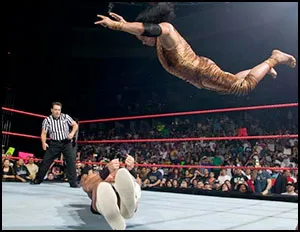 By the early Nineties, pro wrestling had changed a great deal since Snuka originally broke into the business some twenty years earlier. After leaving the WWF, the veteran found himself with few options in terms of places to gain full-time employment, especially with the AWA having ceased operations in 1991 and WCW showing no interest in hiring him. Yet, in 1992, Snuka joined the new Philadelphia-based Eastern Championship Wrestling and unknowingly wrote himself into the history books once again. Although the ECW that Snuka competed in was still a few years away from going “extreme,” the no-frills, hard-hitting and bloody brand of action that Eastern Championship Wrestling delivered was still a major change of pace from the WWF and WCW. On April 25, 1992, after both men had won separate qualifier Battle Royals, Snuka faced off against Salvatore Bellomo in a match to determine the first-ever ECW Heavyweight champion. Snuka won the match, yet, the very next night he was defeated by up-and-coming indy worker Johnny Hot Body. Undaunted, the popular Superfly continued to compete in ECW and eventually worked his way back into the title picture. On July 14, 1992, Snuka met and defeated Johnny to become a two-time ECW champion. He then went on to defend his championship for several months before losing the belt to his early-Eighties archrival from the WWF, Don “The Rock” Muraco, on September 30, 1992.
By the early Nineties, pro wrestling had changed a great deal since Snuka originally broke into the business some twenty years earlier. After leaving the WWF, the veteran found himself with few options in terms of places to gain full-time employment, especially with the AWA having ceased operations in 1991 and WCW showing no interest in hiring him. Yet, in 1992, Snuka joined the new Philadelphia-based Eastern Championship Wrestling and unknowingly wrote himself into the history books once again. Although the ECW that Snuka competed in was still a few years away from going “extreme,” the no-frills, hard-hitting and bloody brand of action that Eastern Championship Wrestling delivered was still a major change of pace from the WWF and WCW. On April 25, 1992, after both men had won separate qualifier Battle Royals, Snuka faced off against Salvatore Bellomo in a match to determine the first-ever ECW Heavyweight champion. Snuka won the match, yet, the very next night he was defeated by up-and-coming indy worker Johnny Hot Body. Undaunted, the popular Superfly continued to compete in ECW and eventually worked his way back into the title picture. On July 14, 1992, Snuka met and defeated Johnny to become a two-time ECW champion. He then went on to defend his championship for several months before losing the belt to his early-Eighties archrival from the WWF, Don “The Rock” Muraco, on September 30, 1992.
On March 12, 1993, in Radnor, Pennsylvania, the two-time former ECW Heavyweight champion added to his title resume by defeating Glen Osbourne in the finals of a tournament to crown the ECW World Television champion. The Superfly then went on to hold the promotion’s secondary title for over a half-year before losing it to another famous veteran who was also trying hard to help establish ECW as a legitimate promotion, Terry Funk. In fact, along with the Funker, Jimmy Snuka was a primary source of credibility for the new league during its early days and he truly helped establish ECW as a major promotion. Following his lengthy run in ECW, Snuka continued working for several east coast independents as his incredible career finally began to wind down after nearly thirty years.
Toward the end of the decade and into the new millennium, the legendary Superfly made several brief but high-profile appearances in WCW, WWE and TNA while continuing to sporadically appear in independent groups throughout the northeast. However, it was obvious that The Superfly’s long and storied career was clearly winding down, rapidly. Meanwhile, the dark cloud of nagging questions regarding Snuka’s involvement in the death of Nancy Argentino silently followed him wherever he roamed.
On May 10, 1983, Allentown, Pennsylvania police were called to Snuka’s room at the George Washington Motor Lodge. Once there, they found his 23-year-old paramour Nancy Argentino in a physically battered state and immediately transported her to Sacred Heart Medical Center, where she was pronounced dead shortly after arrival. The subsequent coroner’s report stated that Argentino passed away due to traumatic brain injury. Her autopsy results showed that Argentino had suffered numerous cuts and bruises all over her body, possibly indicating domestic abuse. Although he was taken in for questioning, Snuka, the primary suspect, was not charged with any wrong doing and was released immediately after his interrogation. Two years later, however, Ms. Argentino’s family won a wrongful death civil case against Snuka after he failed to appear in Philadelphia’s U.S. District Court. The Argentino family received a $500,000 judgement, of which Snuka subsequently made no payments. For Nancy Argentino’s family, and in the eyes of many who were familiar with the case, it seemed that Snuka had evaded justice not once but twice.
Years passed and although the Argentino case remained open, there were no new developments and it sat inactive, serving as the literal definition of a ‘cold case’. But, after the 2012 release of his autobiography, Superfly: The Jimmy Snuka Story, in which Snuka’s recounting of the incident seemed to contradict his previous recollections, there was a renewed interest in what actually happened back in 1983. Additionally, a 2013 article by Adam Clark for Allentown’s The Morning Call newspaper published portions of the autopsy report, bringing to light the case’s many idiosyncrasies and raising legitimate questions regarding how police at that time handled the investigation. In 2014, the Lehigh county attorney’s office responded to public pressure and announced that it was officially reinvestigating Argentino’s death.
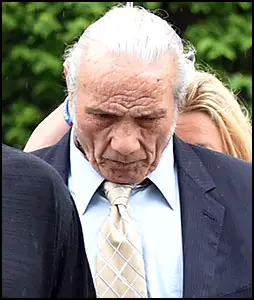 On September 1, 2015, more than three decades after the death of Nancy Argentino, a seventy-two-year-old Jimmy Snuka was arrested by police and charged with third-degree murder and involuntary manslaughter for his involvement in Nancy Argentino’s death. Then, on November 2, 2015, Snuka and his lawyers issued a plea of not guilty before Judge Kelly Banach. A subsequent hearing was scheduled for May of 2016, designed to establish the aging Snuka’s competency for trial, and on June 1, 2016, Judge Banach ruled that Snuka, who was showing signs of dementia, was not mentally fit to stand trial.
On September 1, 2015, more than three decades after the death of Nancy Argentino, a seventy-two-year-old Jimmy Snuka was arrested by police and charged with third-degree murder and involuntary manslaughter for his involvement in Nancy Argentino’s death. Then, on November 2, 2015, Snuka and his lawyers issued a plea of not guilty before Judge Kelly Banach. A subsequent hearing was scheduled for May of 2016, designed to establish the aging Snuka’s competency for trial, and on June 1, 2016, Judge Banach ruled that Snuka, who was showing signs of dementia, was not mentally fit to stand trial.
The judge then ruled that a new hearing would be held in December so that the court could re-evaluate Snuka’s mental state and his competency for trial. On January 3, 2017, Judge Kelly Banach, after finding him mentally unfit to stand trial, dismissed the charges against Snuka. Less than two weeks later, on January 15, 2017, Jimmy Snuka succumbed to stomach cancer and passed away at the age of 73.
“Superfly” Jimmy Snuka is a member of the WWE Hall of Fame (1996), the New England Pro Wrestling Hall of Fame (2010) and the Professional Wrestling Hall of Fame (2012).
